How many times have I been to Seattle? Every time I pass through here I find something new to see, and I've gotten more familiar with this city than any other that I've never lived in, except maybe Austin.
Monday, August 19, 2024
I stepped off the Bass Canyon shuttle bus in the parking lot by Lumen Field, the huge stadium where the Seahawks, Sounders, and Reign play. I had a hotel to get to, but couldn't check into until three, and the time was only 12:55. So I would have to really slowly take my time heading north to that hotel.
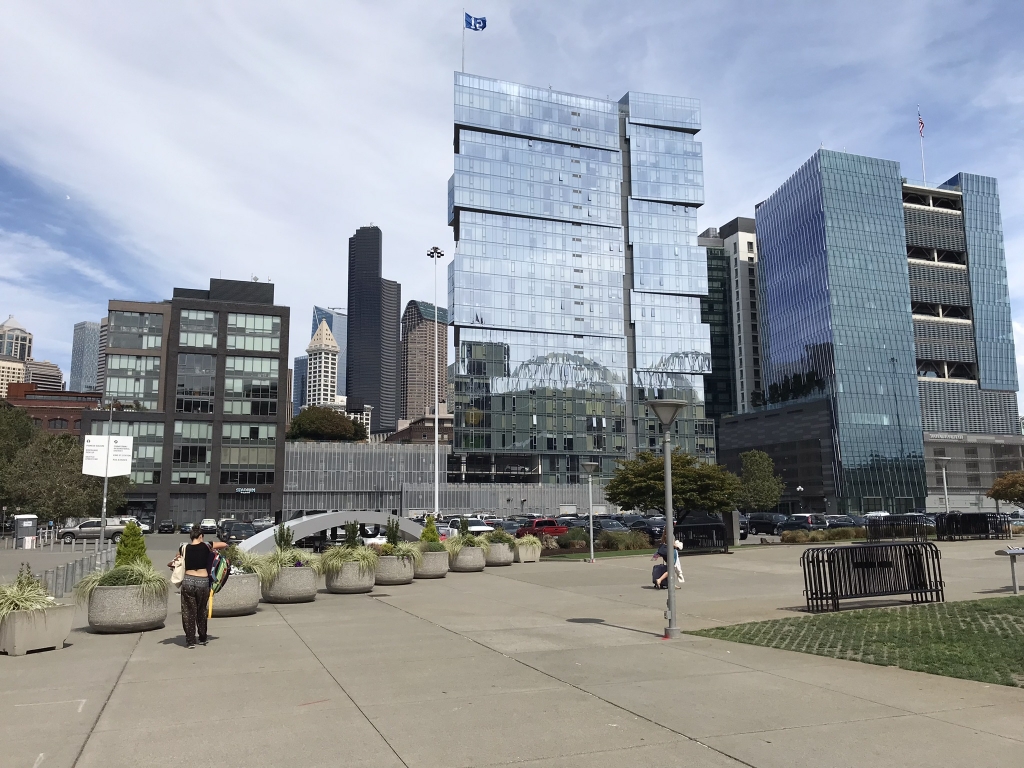
Looking at the Seattle skyline, around where I stepped off the bus. On that shiny building in the center, you can see the reflection of Lumen Field which was behind me.
I rode a light rail train to the Westlake station, which is in the middle of downtown. From there I just wandered around looking for something that stood out. Victrola Coffee Roasters turned out to be a great place to stop for coffee and lunch.
My hotel was the Travelodge by Wyndham Seattle North of Downtown. It was nowhere near the light rail, but could still be easily reached on one of Seattle's express buses, bus E. Seattle has the usual network of buses with numbered routes, but also has a handful of express routes with letters instead of numbers. Throughout this trip I used bus E several times and was quite impressed with how efficient it was. There was never any need to check schedules ahead of time before walking to the stop, all I had to do was walk over there when I felt like it and just wait a few minutes. This is the only city bus system in the US that I could ever say that about.
The light rail system is being expanded, too. Looking at the system map whenever I rode any of the trains, they've added a new line, the 2 line, which runs through the suburbs like Bellevue and Redmond on the other side of Lake Washington. Apparently this will be expanded further in the future to connect it with the 1 Line; while riding the shuttle bus from the Gorge earlier that day, I could see the railroad tracks under construction on the bridge over that lake. Seattle's transit is getting better and better.
I didn't have anything planned in the city that day. As soon as I got checked into the Travelodge, the first thing I did was...laundry. While waiting for that to finish up, I logged in, with my phone, to the Canvas account I use for Clovis Community College online classes. The 19th was the first day of the fall semester and I had to log in once to be counted as present. Looking at everything that was to be expected by my Economics and Psychology classes, I started to wonder if I was in over my head. Well, that's something I'd have to wait until after the trip to worry about.
With the laundry done, now ready to head back into downtown, I boarded a southbound bus E. By then the day was winding down so from downtown, I just walked back to the waterfront to look for dinner and some drinks.
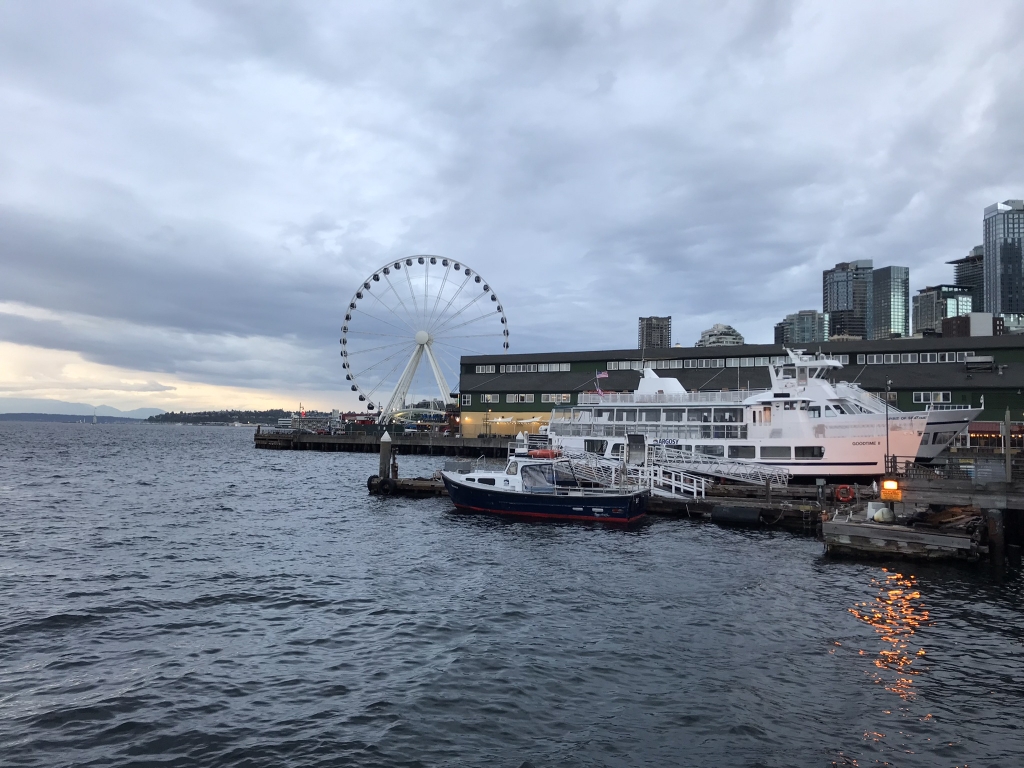
The view from the end of Pier 55. All of these numbered "pier" buildings, like 55 which I was standing in front of and 56 which you see taking up most of the space in this picture, are full of restaurants, bars, souvenir shops, video game arcades, and such. I think this is one of those places that is only frequented by tourists and not locals.
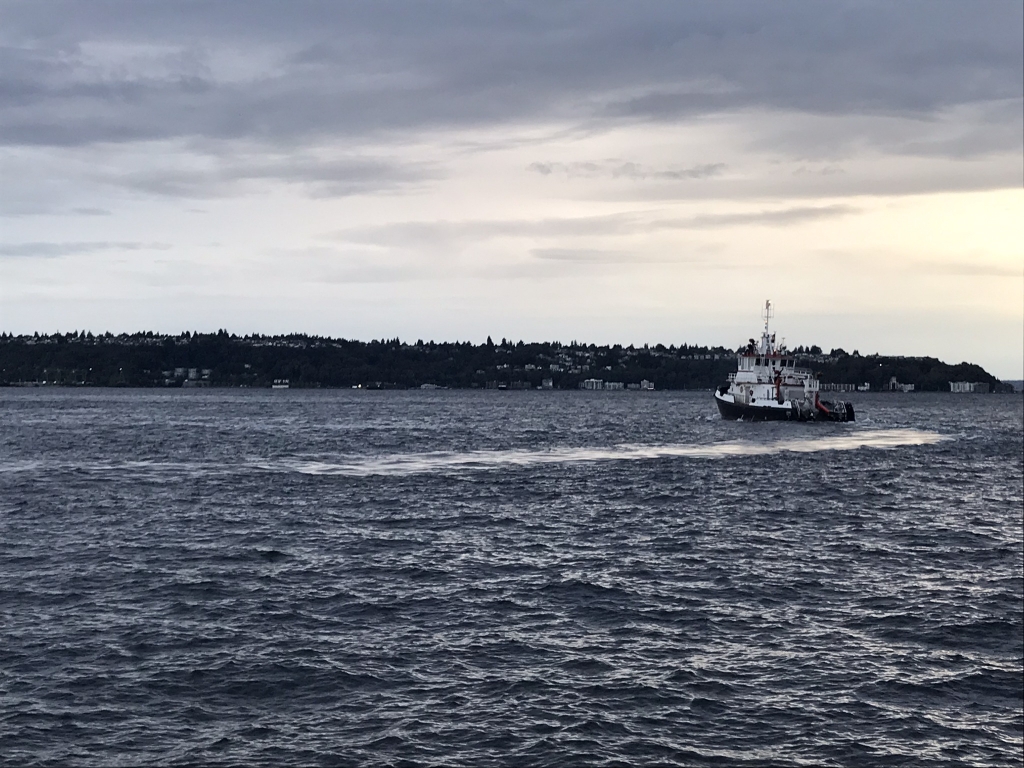
Looking across Puget Sound at Bainbridge Island
I'd been to the Pike Pub before on past visits and found my way there again. I drank a Post Alley Pils, which I thought was just OK, but better than what was at Bass Canyon during the last weekend. Also, because I was really hungry, ate a Burrata & Heirloom tomato salad--arugula, basil, English cucumber, aged balsamic reduction (is that some kind of vinaigrette?), and olive oil--with grilled salmon added. Because I was just that hungry, I also followed that with a pretzel with a kind of mustard made with stout beer.
I made one more stop on the waterfront, Fisherman's, for an Angry Orchard cider before walking back up the stairs to Pike Place.
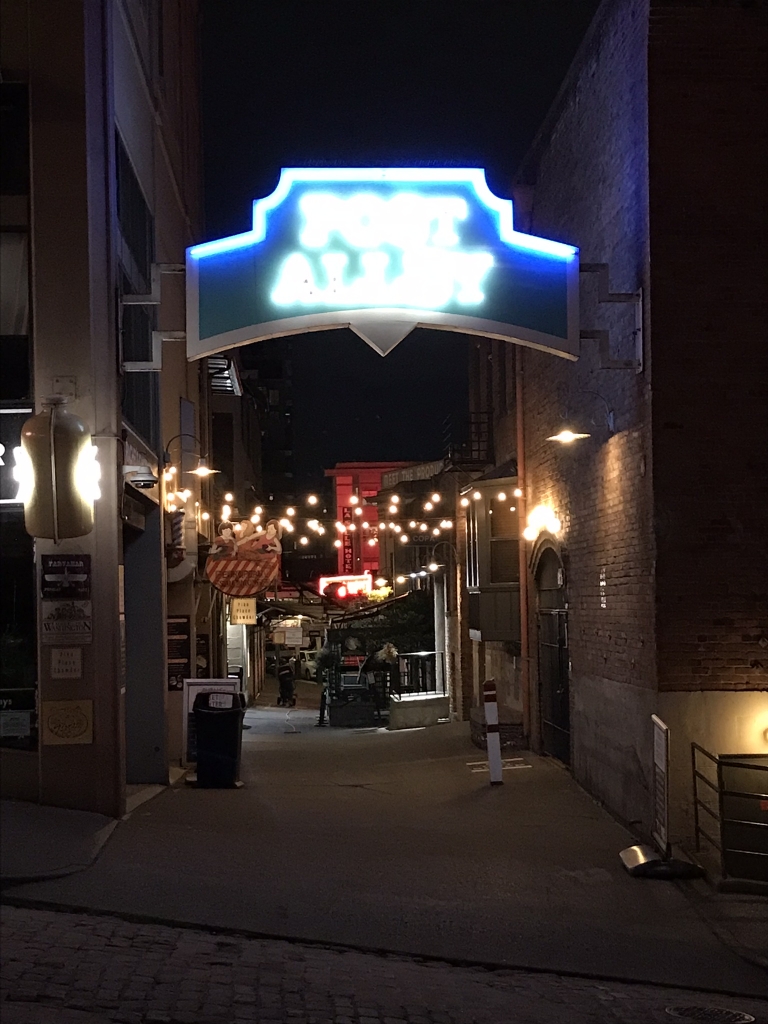
Post Alley is a famous spot near Pike Place Market, and at night is a great spot for bar hopping. Though at this time I just wanted to hop into one and leave it at that. Obviously the sign doesn't look this washed out and fuzzy when you see it in person.
Kells Irish Pub, on Post Alley, is another place I'd been to before and thought was worth another stop. I think they make their own beer, and I had the Irish Style Lager. It was a little bitter, but still the tasty lager I wanted.
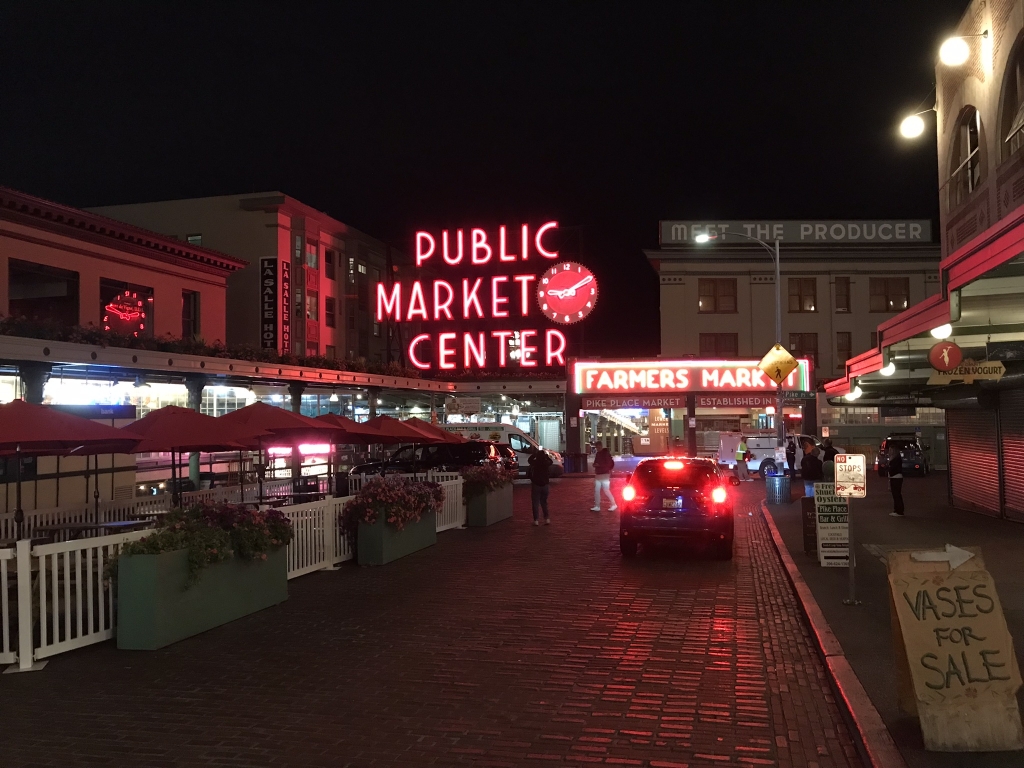
Pike Place Market. I've got many photos of it in different years, but this is the only one at night.
Tuesday, August 20, 2024
Looking for breakfast that morning, instead of going to some upscale downtown place, I just walked down Aurora Ave. and picked something that stood out. That turned out to be the Sunrise Restaurant at Aurora and 79th. Now this is a great little hole-in-the-wall place that I think attracts more locals than tourists. What I got was a pesto scramble: eggs scrambled with spinach, feta, mushrooms, and pesto, along with hash browns and a choice of toast, for which I chose a biscuit. It was delicious but so huge that I only ate half and took the rest back to the hotel for tomorrow.
My first destination was the Museum of Flight, which I can't believe I never visited in all the times I'd been to Seattle before. That may be because it's just a bit more out-of-the-way than other attractions, being located at the south end of Boeing Field. That's not the big international airport, but a smaller one mostly used for cargo flights and general (non-commercial) aviation.
Getting to the Museum of Flight on transit wasn't that hard, though. After riding express bus E into downtown, I rode the light rail to the SODO station. From there, I had to walk some distance east on Lander St. to its T intersection with Airport Way. Then on that street, I had to catch southbound bus 124 and ride that for some time. Eventually that bus goes down Marginal Way, and there's a stop right there across the road from the museum.
At that time, admission to the museum cost $26.
The Museum of Flight is exactly that; it's dedicated to not only flight in the air, but in space as well. This is what the Charles Simonyi Space Gallery focuses on.
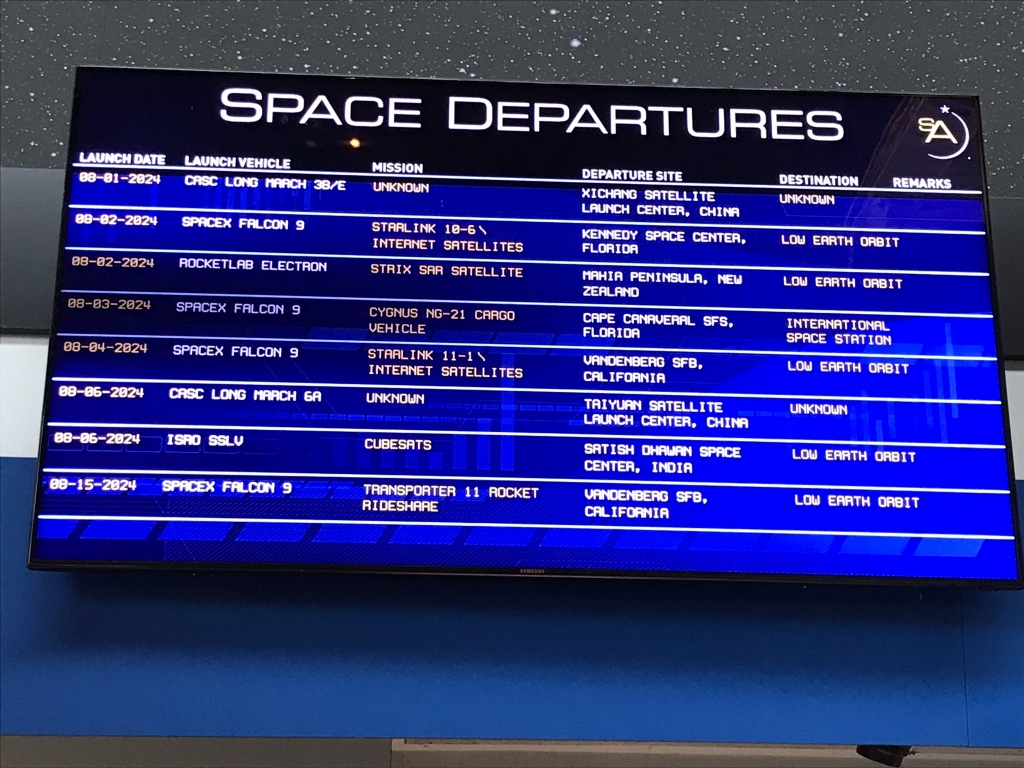
One of the first things you see in the Space Gallery is this list of upcoming space launches.
The first exhibit I gravitated to was a Russian Soyuz command module that flew an International Space Station mission in 2009 and was on display here. When it launched, it carried a "space tourist," the Hungarian-American billionaire software engineer Charles Simonyi, whose name graces this gallery, to the ISS. It returned to Earth with a different billionaire space tourist, Canadian Cirque du Soleil founder Guy Laliberté.
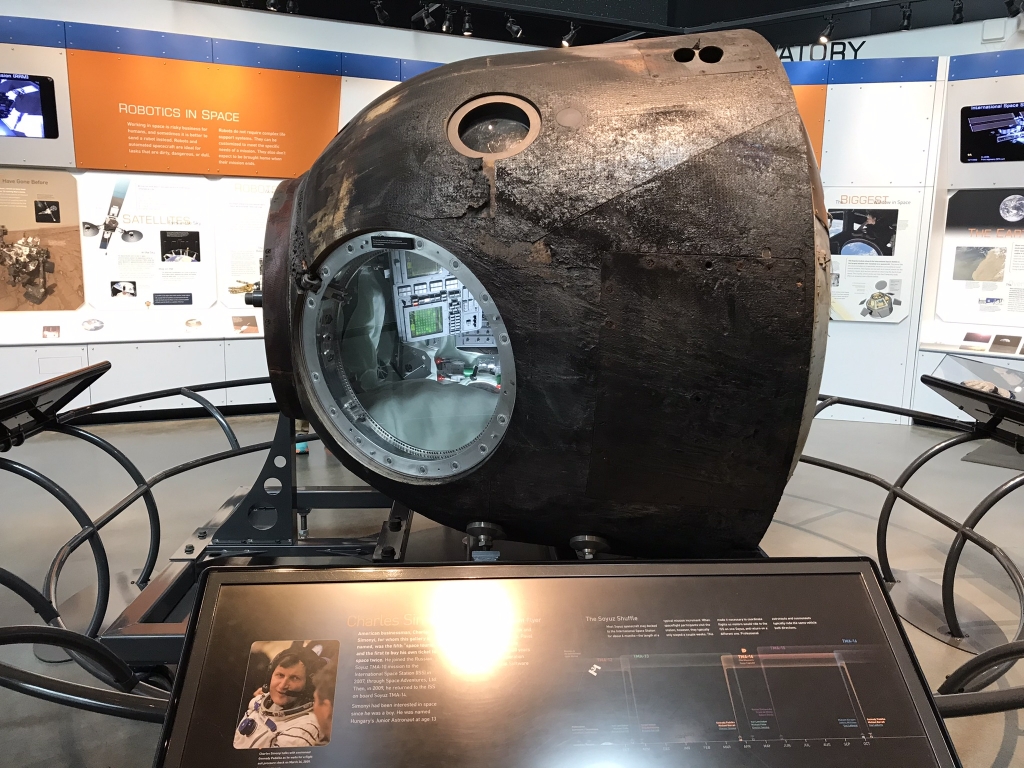
Russia, and its predecessor the Soviet Union, have been launching Soyuz capsules into space since the 1960s. They're single-use, only flying one mission and then being shipped off to be displayed somewhere like here. Generations of engineers have, of course, upgraded the design through the decades; everything inside this craft would be unrecognizable to anyone who flew in one back in the '60s and '70s. But this isn't the whole space vehicle; it's only a third of what flies in space since the rest is always disposed of to burn up in the atmosphere.
This is a rare moment when I'm actually going to share a picture of an informational sign, because it needs a look to really understand what you're seeing.
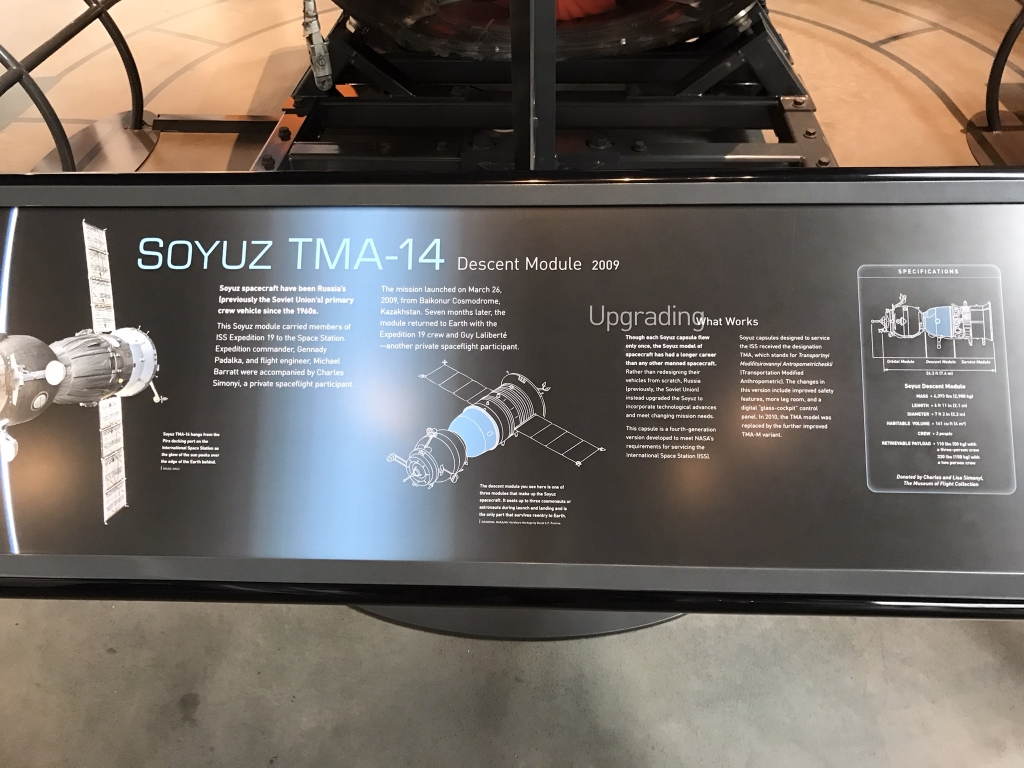
You may be familiar with what a Soyuz looks like when it's flying in space. You can see that in the diagram here. The descent module, what they have on display here, is highlighted in magenta on the drawing. As you see, each Soyuz has three modules; that spherical section in the front contains living and working space, the middle bell shape is the descent module that is actually on display, and the rear cylindrical module with the solar panel is the service module with the engines and oxygen tanks. It's only the descent module that reenters the atmosphere at the end of every mission, while the other two modules get thrown away and burn up in the atmosphere.
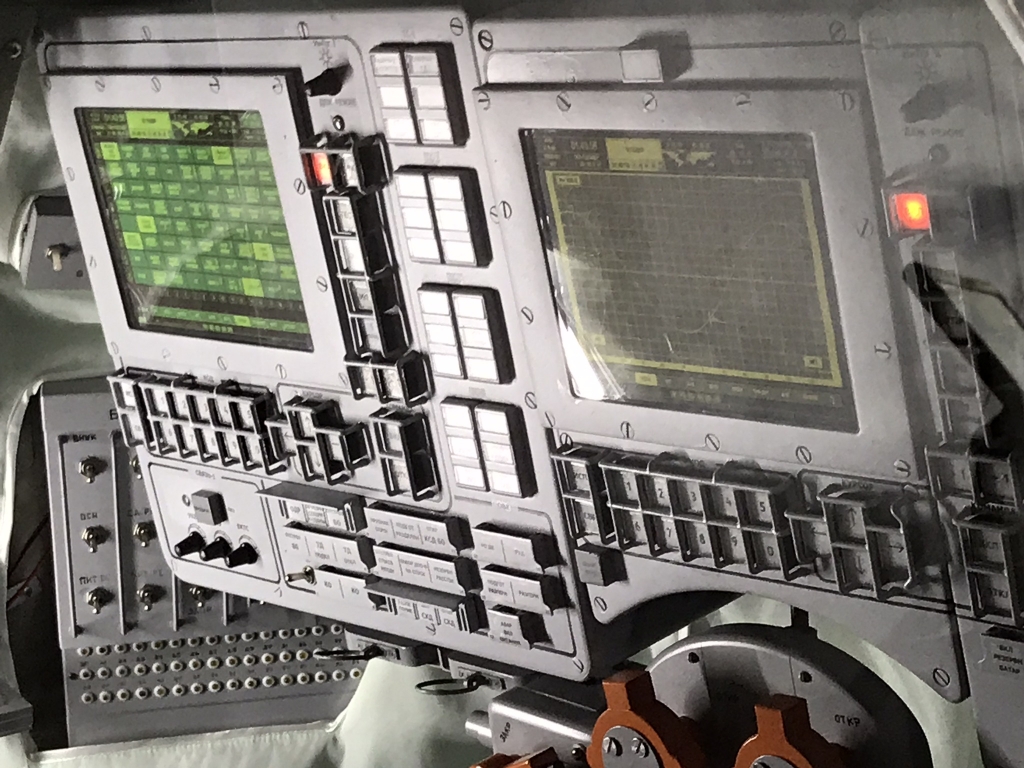
I had to take a picture through one of the little windows on the capsule, of one of the control panels. While the exterior of the Soyuz has stayed the same through the last half-century, the systems and instruments have been regularly been modernized with each successive generation. This particular capsule was of the fourth generation, and has since been superseded by a fifth generation in 2010. Alexei Leonov surely never looked at screens like this when he piloted a Soyuz to dock with an Apollo in 1975.
Now finally moving on, here's a scale model of a Chinese Shenzhou spacecraft.
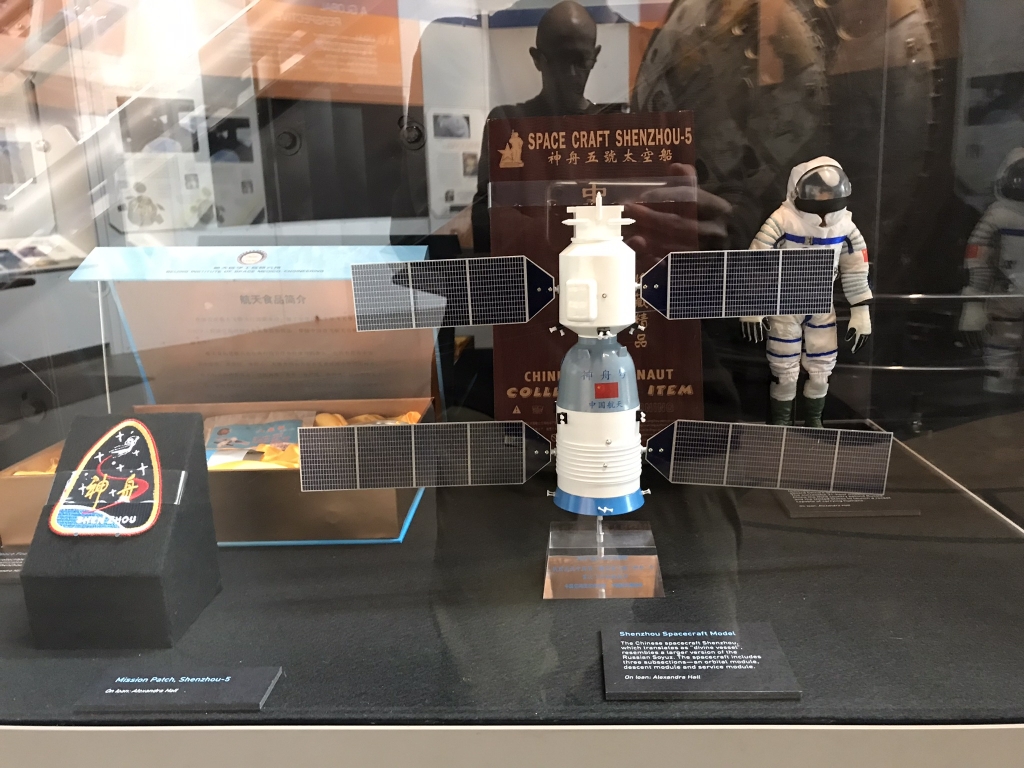
China has a space program that is quite overlooked by Western media. We all know about the US and Russia launching people into space, but we forget that China does this too. Looking at this model, the Shenzhou appears quite similar to the Russian Soyuz with its three modules. I'm pretty sure that gray part is the descent module, and at the end of a mission the rest probably gets cut loose to burn up while the descent module returns to Earth just like with the Soyuz.
China uses these Shenzhou spacecraft to service their Tiangong space station. Yeah, you probably didn't even know that there's a Chinese space station! That's what I meant by "overlooked by Western media." We'll see a model of that station a little later.
Now on to some exhibits related to the venerable American Space Shuttle program.
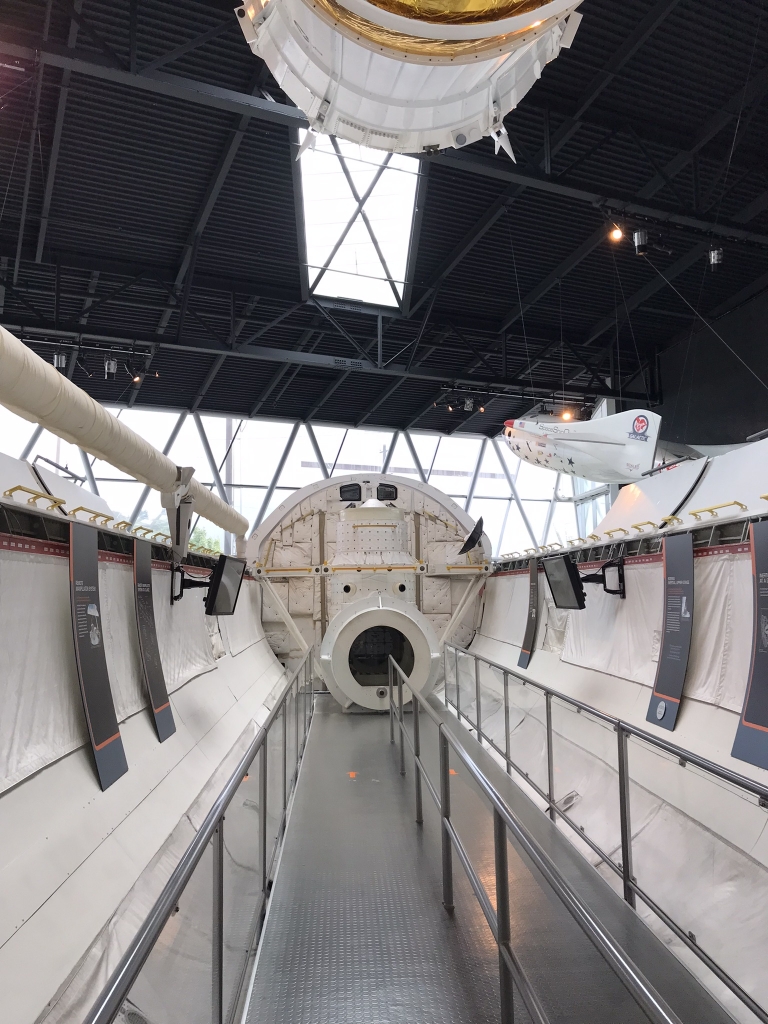
This is a mock-up of a Space Shuttle cargo bay, which used to be used for training Space Shuttle astronauts.
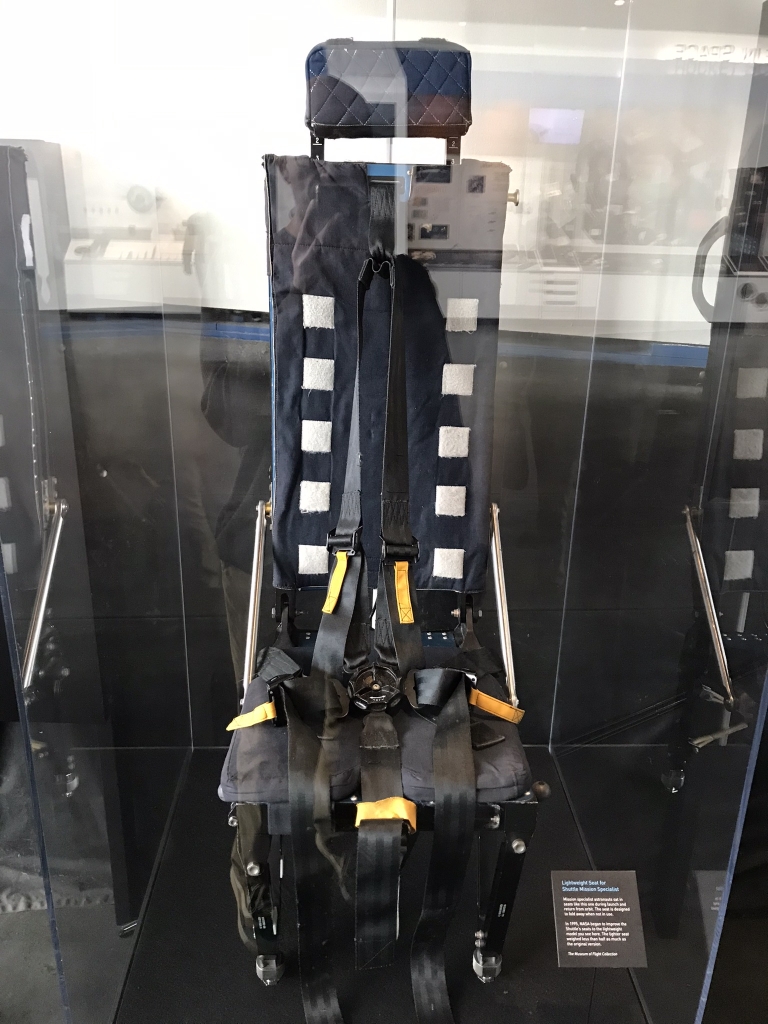
A mission specialist's seat. The little sign explains this is a lightweight seat that replaced heavier seats in 1995. It doesn't, however, specify exactly which Shuttle this was used in.
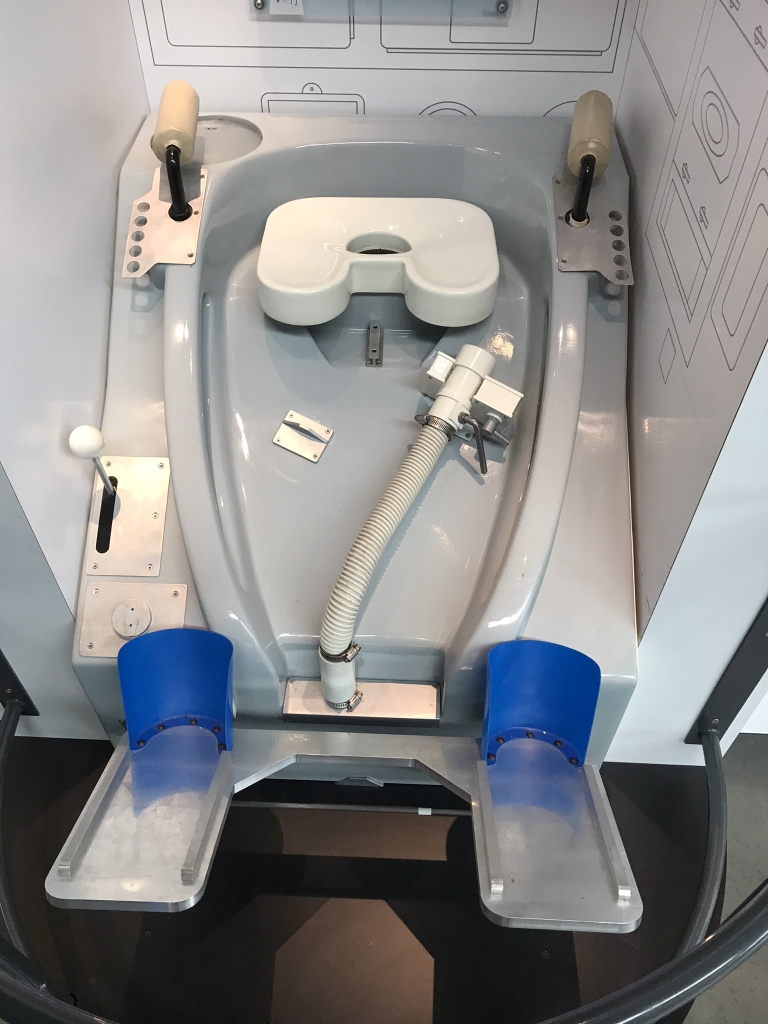
Here is a 1:1 scale model of a Space Shuttle toilet. Using the bathroom in zero-gravity has its own set of challenges.
Now we move on to the Aviation Pavilion, which has several airplanes from various eras, some of which you can walk through.
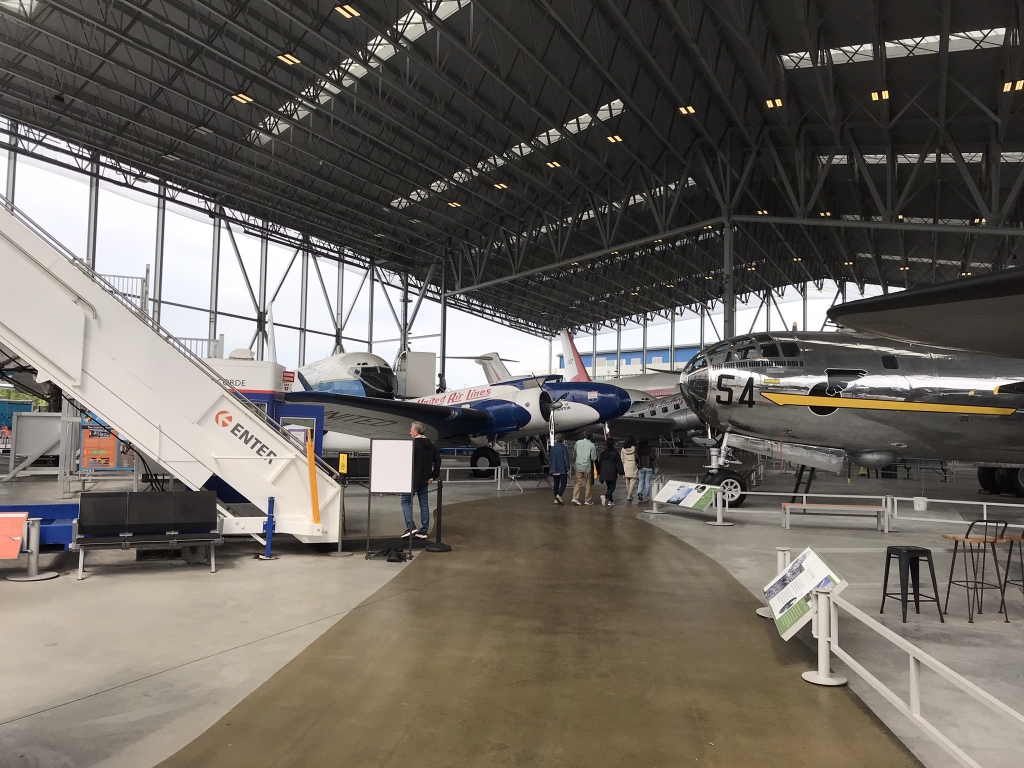
First, we're going to take a close look at a Concorde. Have you ever heard of this legendary passenger jet? The Concorde was a supersonic passenger plane that could cross the Atlantic ocean in three hours, flying twice the speed of sound. British Airways and Air France each flew seven, and they could only fly over the ocean because of how disruptive the sonic booms would be to people on the ground.
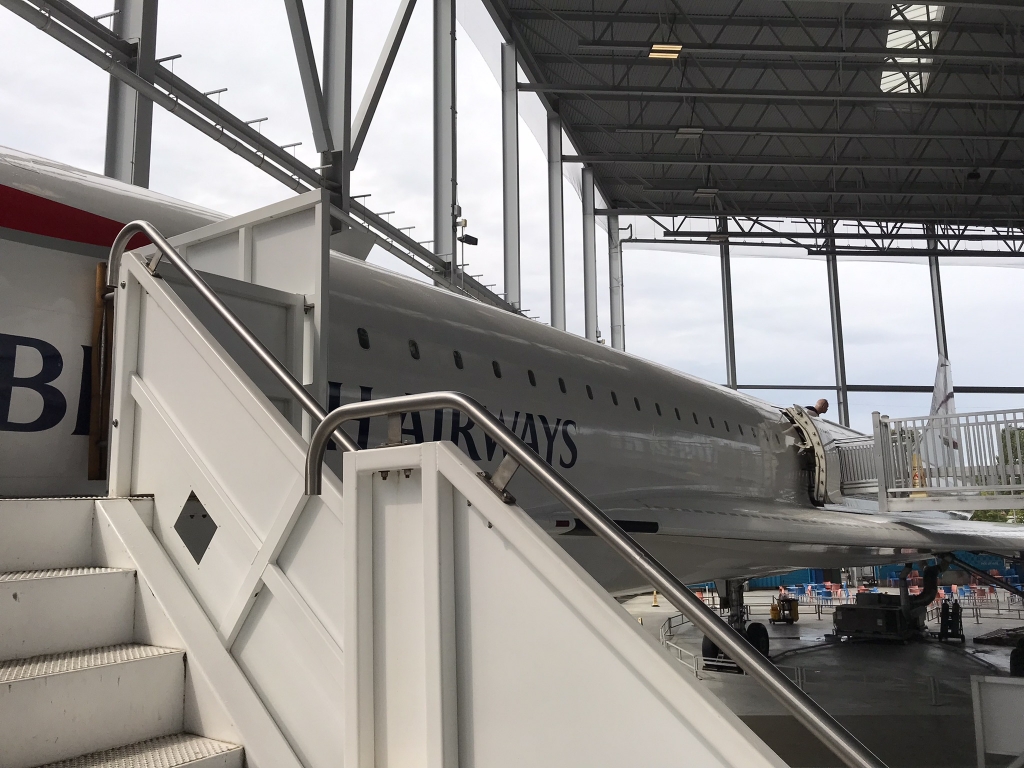
This Concorde was so long, it was impossible to get a picture of the whole thing.
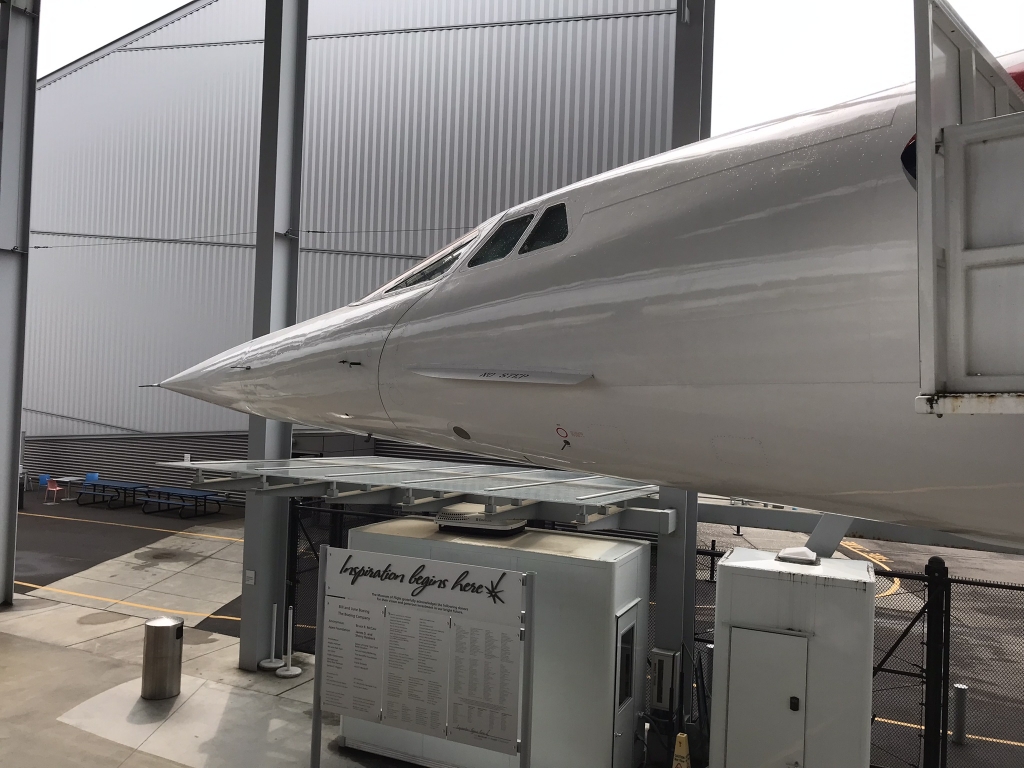
The Concorde had a "droop nose." That nose cone would extend and point slightly downwards during takeoff and landing, and then retract to what it looks like here during flight, for aerodynamic reasons.
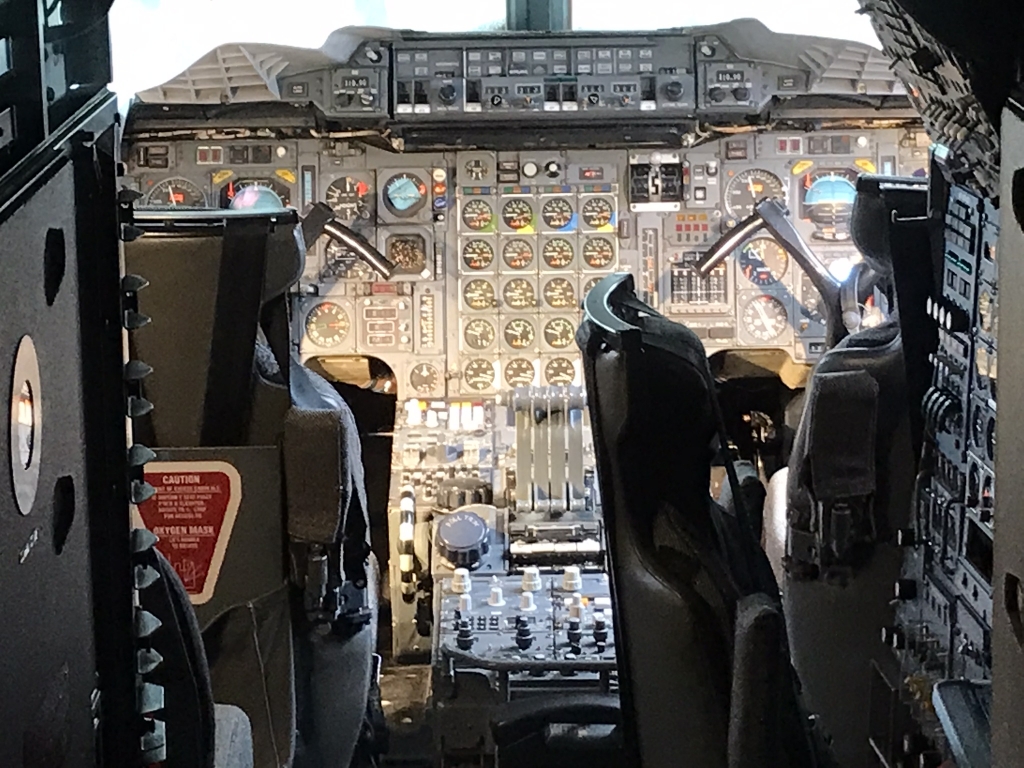
Concorde cockpit. We can only guess what all those gauges indicate.
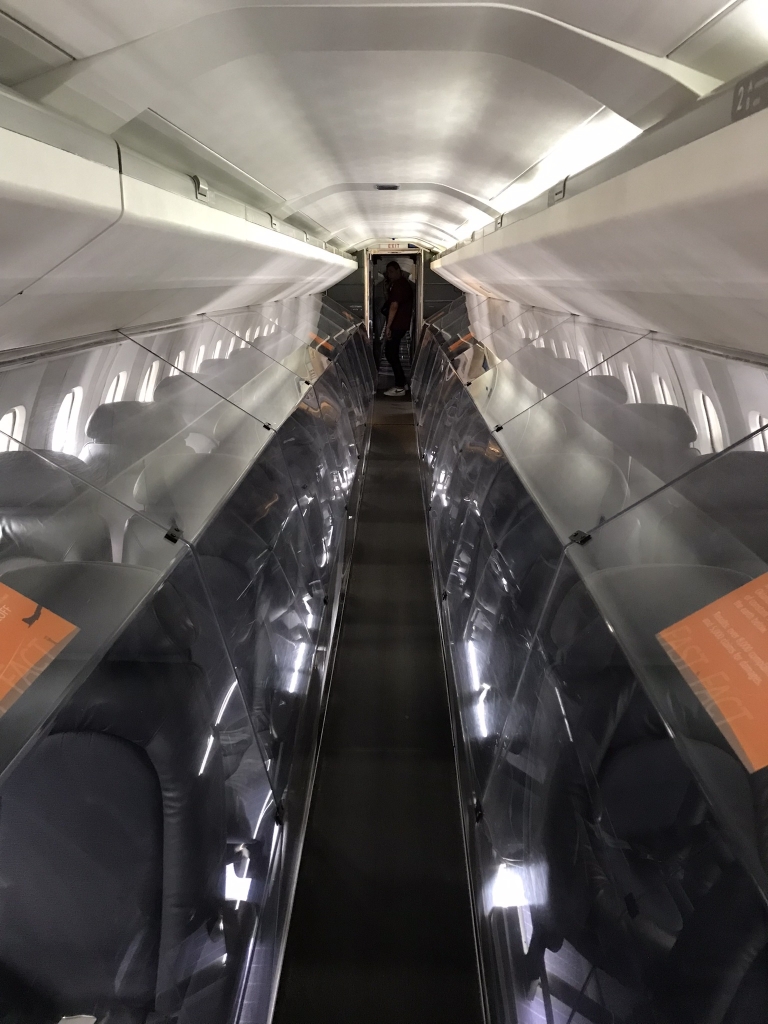
Concordes were long but quite narrow, and didn't carry more than 128 passengers.
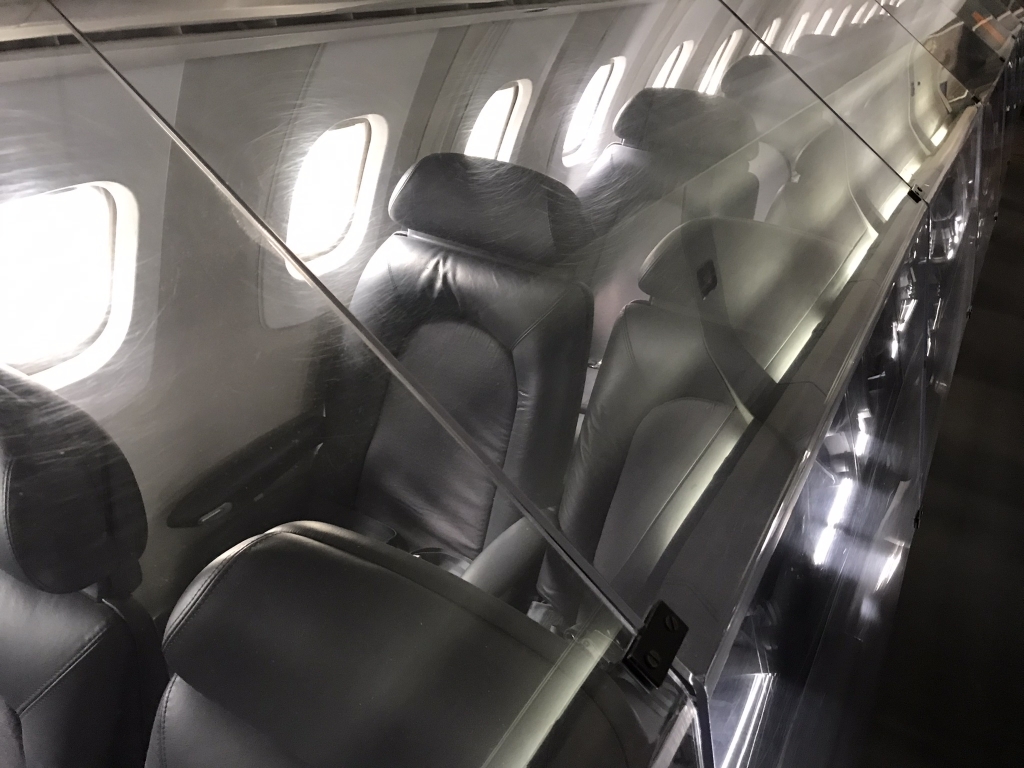
Those seats look a little nicer than most other passenger planes'. Too bad they won't let you sit on one.
I first found out about the Concorde long, long ago, from this ludicrous disaster movie I saw several times growing up, The Concorde... Airport '79. It was your typical '70s disaster epic, with a murky plot involving a shady arms merchant sabotaging a Concorde just to kill one passenger, everything aboard going wrong that possibly could go wrong, and a dozen or so subplots revolving around the various passengers. It was the sort of thing that made me think "This is SO cool!" when I was watching it on Sunday-afternoon TV at six years old, but then "This is SO stupid" when rewatching it in my early 20s.
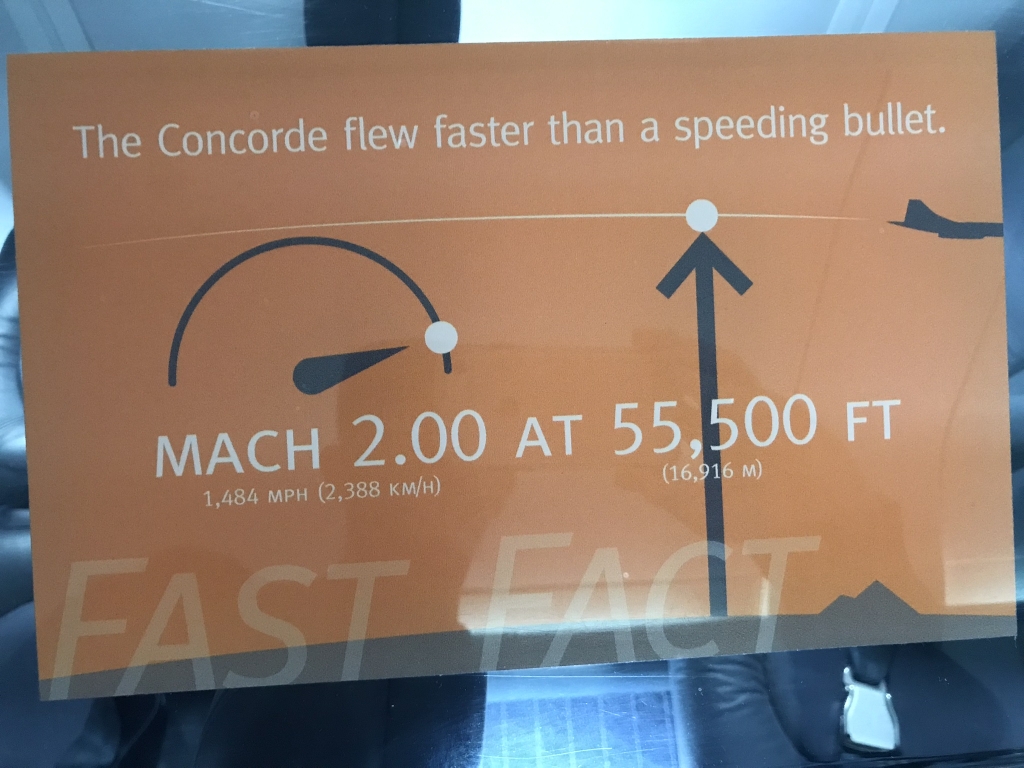
The Concorde crossed the Atlantic at twice the speed of sound, literally faster than a speeding bullet. New York City is five hours behind London, but this jet could make the journey in three. That means that traveling westward felt like traveling back in time. Imagine taking off from Heathrow at noon, and then landing at JFK at 10am! Phil Collins once famously used a Concorde to perform at two Live Aid shows on the "same night" in 1985, first in London, and then in Philadelphia.
During the Concorde's operational history, there was only one fatal crash, which happened in 2000 shortly after takeoff outside Paris. Everyone aboard was killed, and this was the beginning of the end for the Concorde. The aircraft were already quite expensive to operate because of the cost of all the fuel required for supersonic flights, the mid-'70s planes were getting old with no replacements in sight, and after the crash passenger numbers never recovered. Both British Airways and Air France retired their Concorde fleets in 2003.
In a somewhat dark coincidence, the Concorde that crashed was the same one that was used for the filming of that ridiculous movie 21 years earlier.
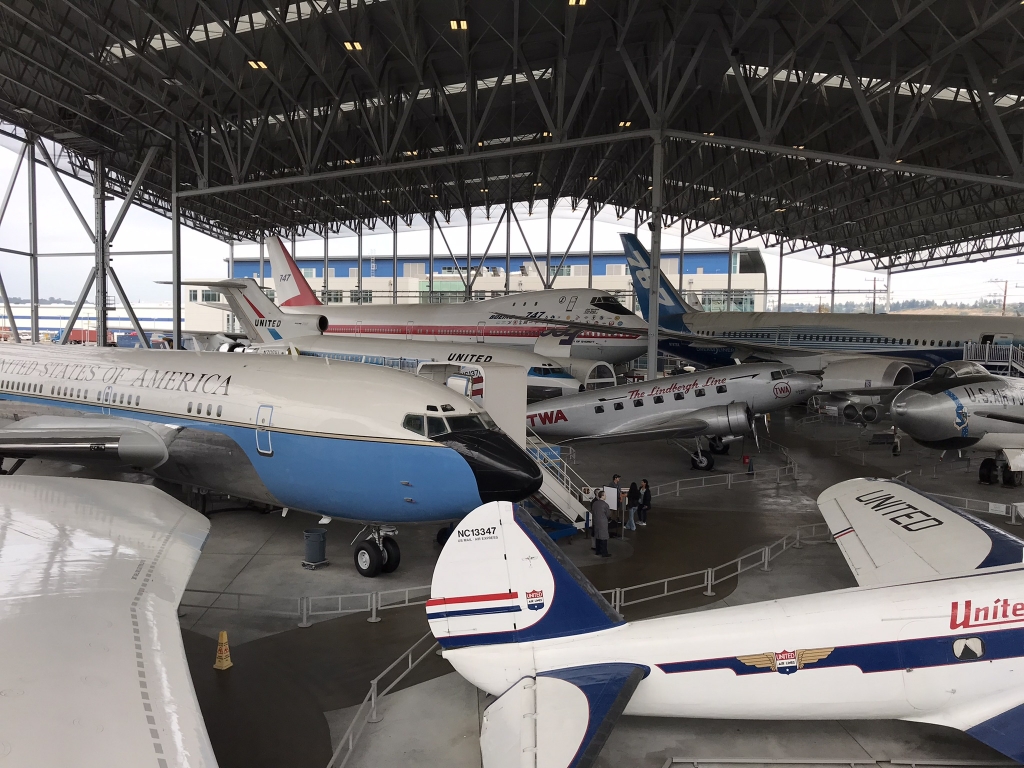
Stepping out of the Concorde, take a look at what else you can walk through. The plane on the left side, closest to where we're standing, looks like a presidential plane, and that's what we'll look at next.
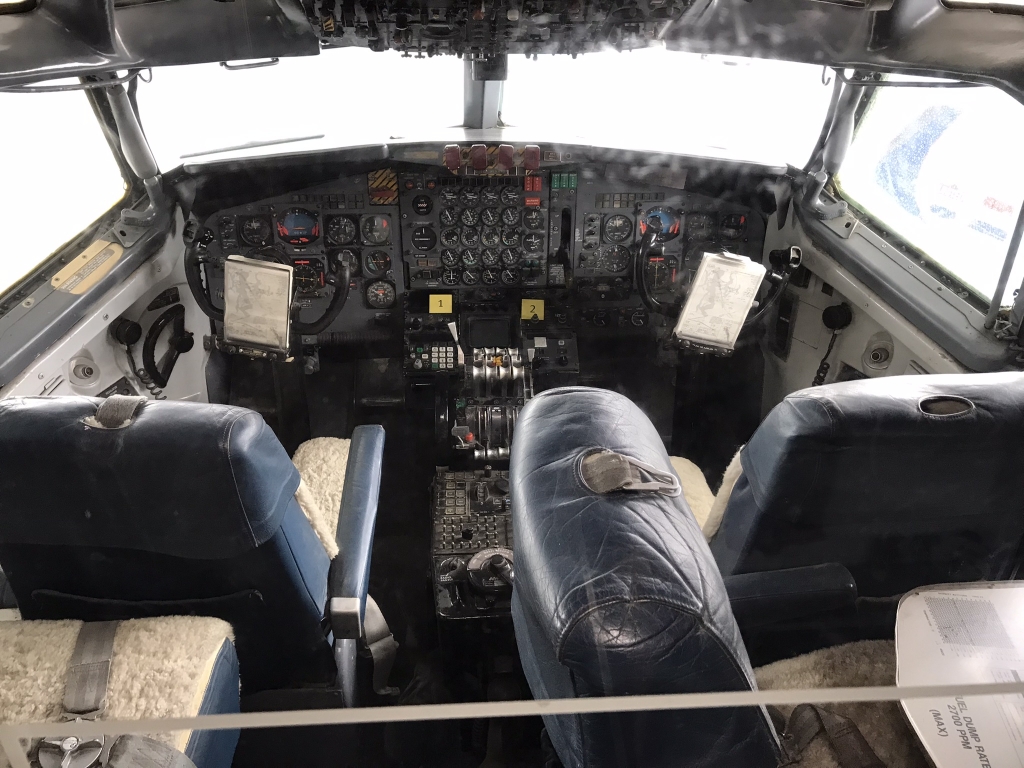
The cockpit of a VC-137, a.k.a. Boeing 707, used as "Air Force One" for Presidents Eisenhower, Kennedy, Johnson, and Nixon. This was the first jet aircraft to have that role.
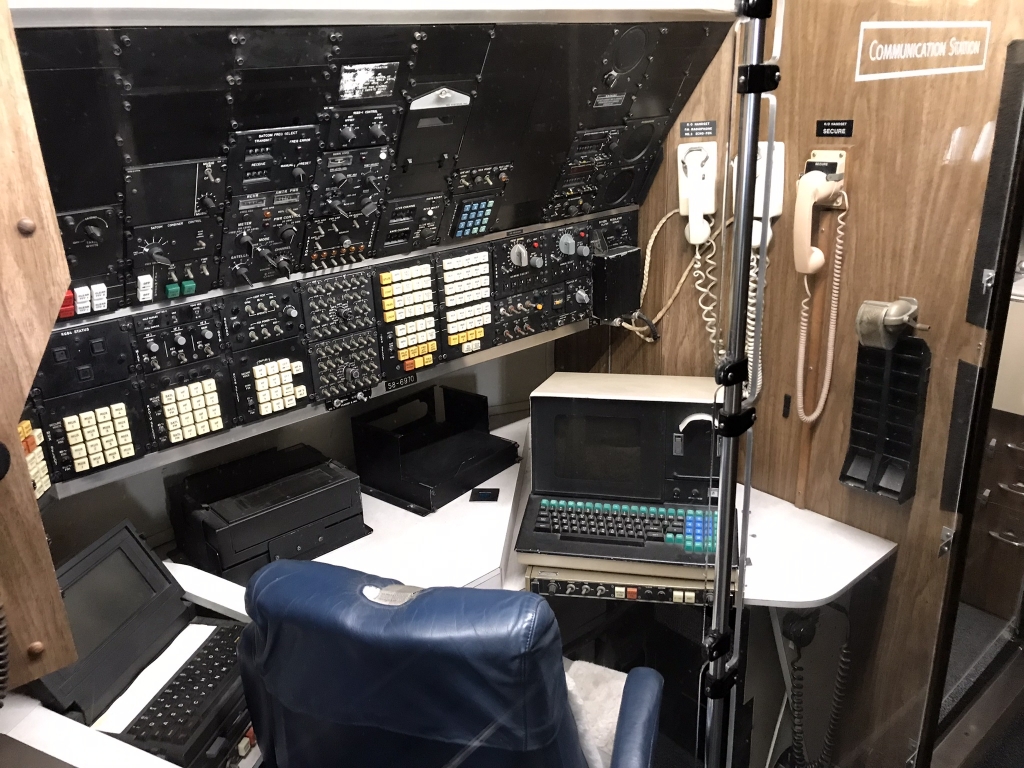
The communication station. This plane was part of the presidential fleet all the way until 1996, which probably explains the two computer terminals that look a little more recent than the Nixon era.
This aircraft has quite a history. President Dwight Eisenhower flew it to Europe in 1959, becoming the first US President to fly in a jet. The Soviet Premier Nikita Krushchev toured the US in it the same year, a tour which began with his address to the United Nations in New York City. Lyndon B. Johnson, while still Vice President, flew it to Dallas on the day President John F. Kennedy was assassinated in 1963, and left on another VC-137 as the new President. Finally, it was on this plane that President Richard Nixon made his historic 1972 visit to China.
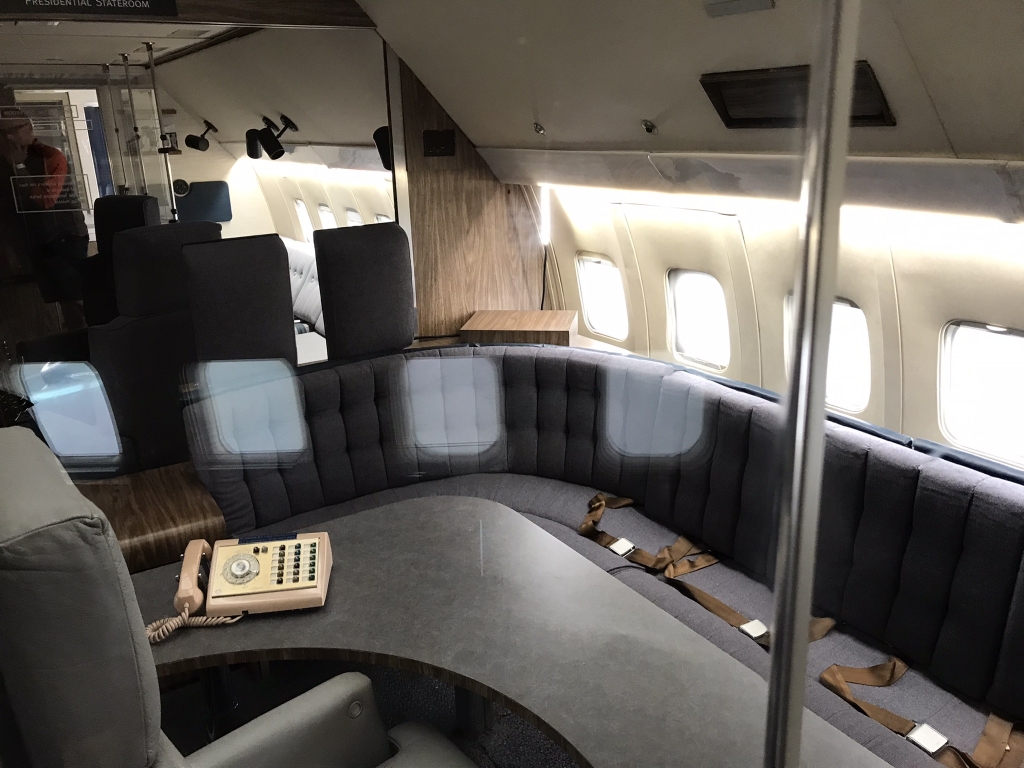
Air Force One conference room
Stepping back outside into the hangar...
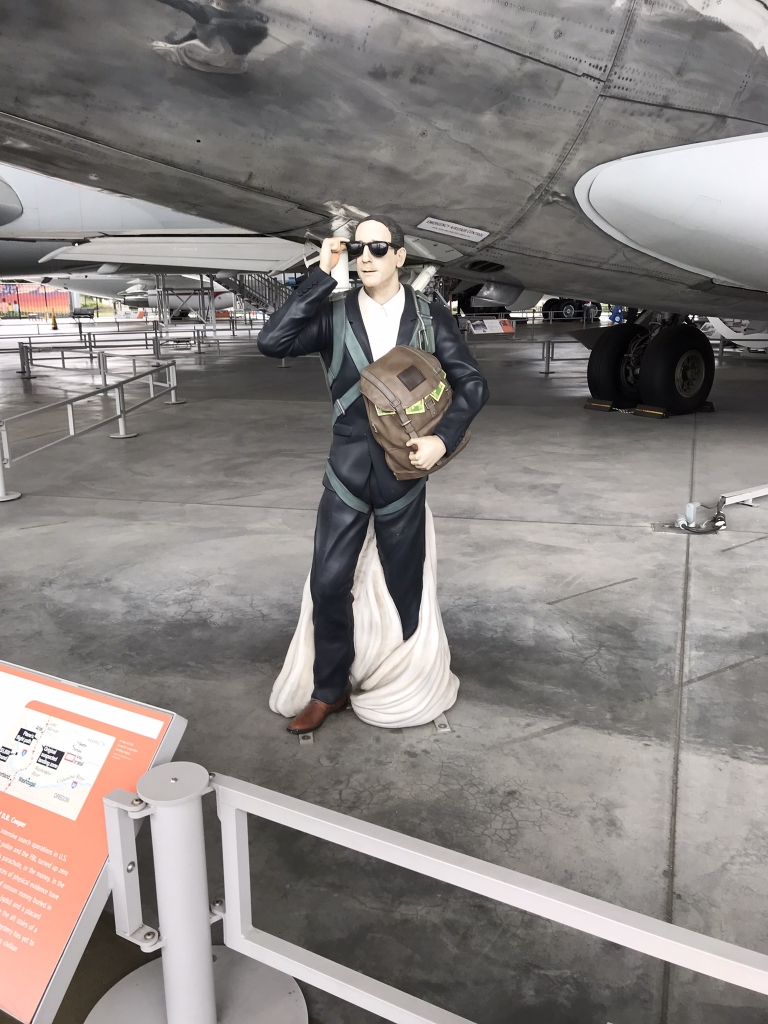
Ever heard of D.B. Cooper? He's the subject of one of the most famous unsolved FBI cases, and something of a local legend in the Seattle and Portland areas. Back in 1971, this mysterious man who gave his name as "Dan Cooper"--the "D.B." is the result of a journalist's error--hijacked a flight from Portland to Seattle, claiming he had a bomb in his briefcase. All he wanted was $200,000 in cash and four parachutes. He got what he demanded in Seattle, where the passengers were all let out, and after the plane took off again, bound for Portland, he strapped on one of the parachutes and jumped out the back, never to be seen again. So just what happened to him? The FBI and countless professional and amateur investigators have been trying to figure that out for decades.
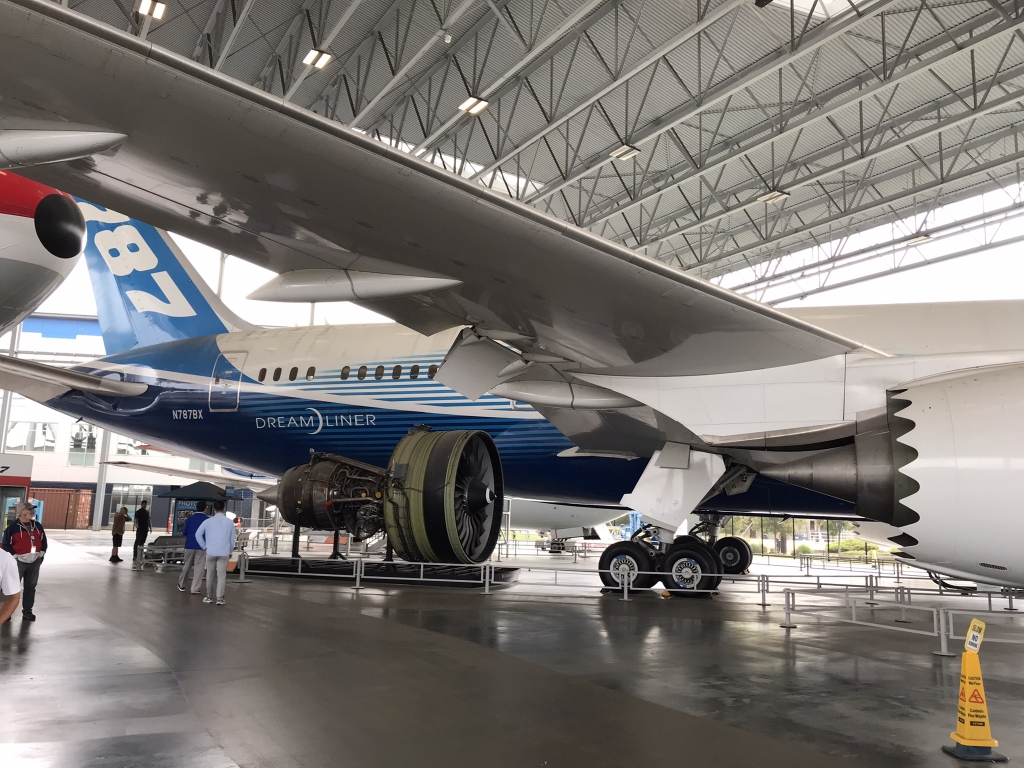
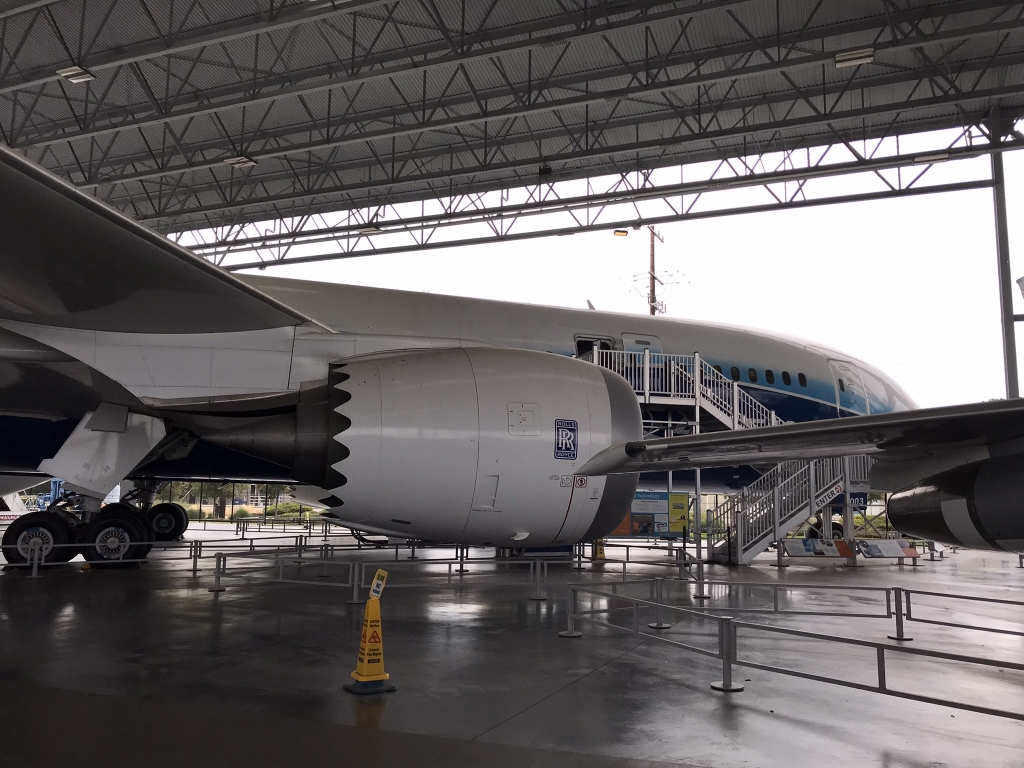
A Boeing 787 Dreamliner, which I've heard has had its issues. It's the most modern jumbo jet designed by Boeing--though with the construction of most sections contracted out to various companies around the world--to be used for long-haul flights.
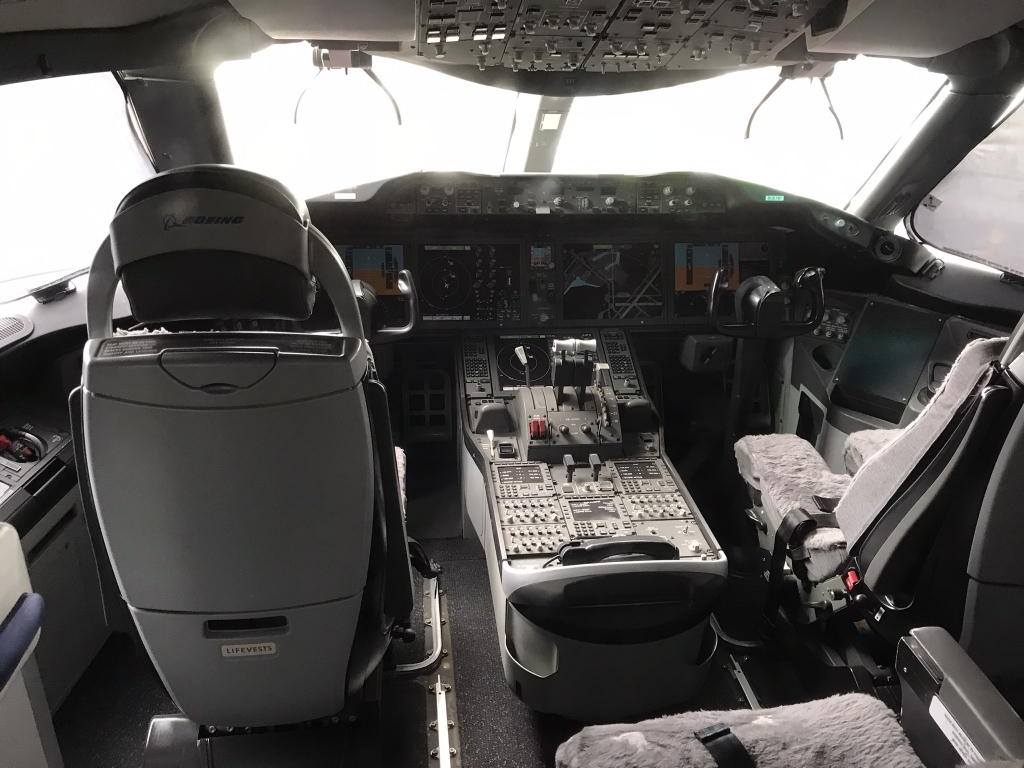
787 cockpit. This is what's called a "glass cockpit" because of all the display screens. It's definitely a bit more modern than the last one we saw, from the old Air Force One.
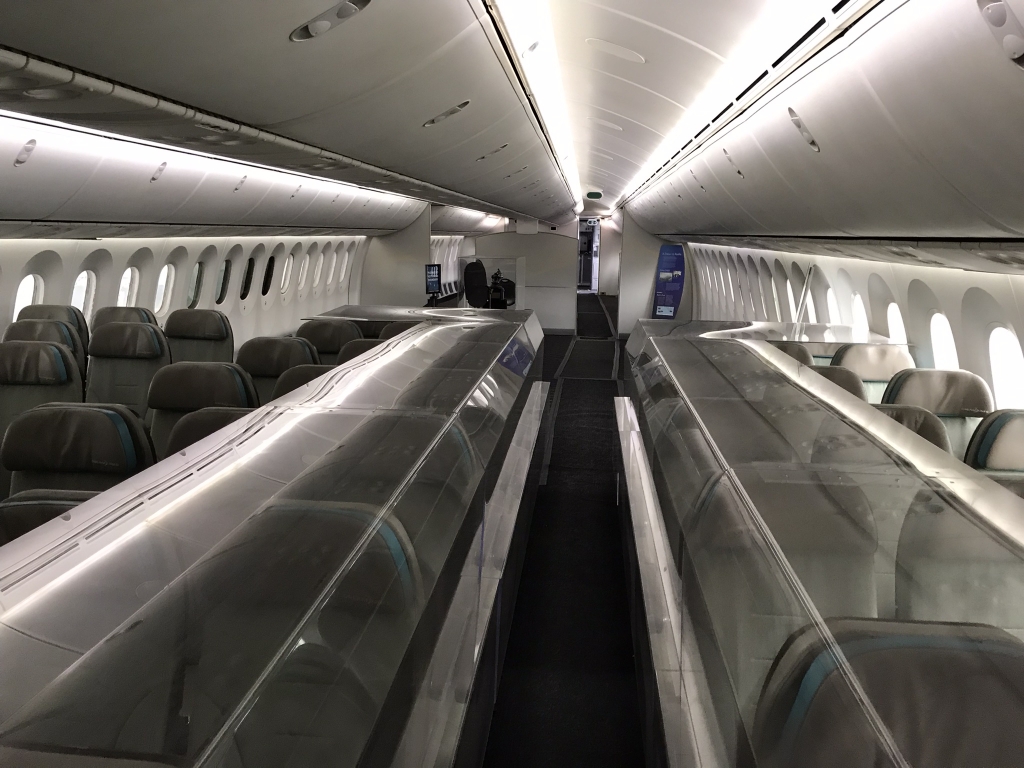
787 passenger cabin. I've ridden one of these at least once; when I moved from Germany back to the US in 2021, it was a United 787 that took me from Frankfurt to Houston.
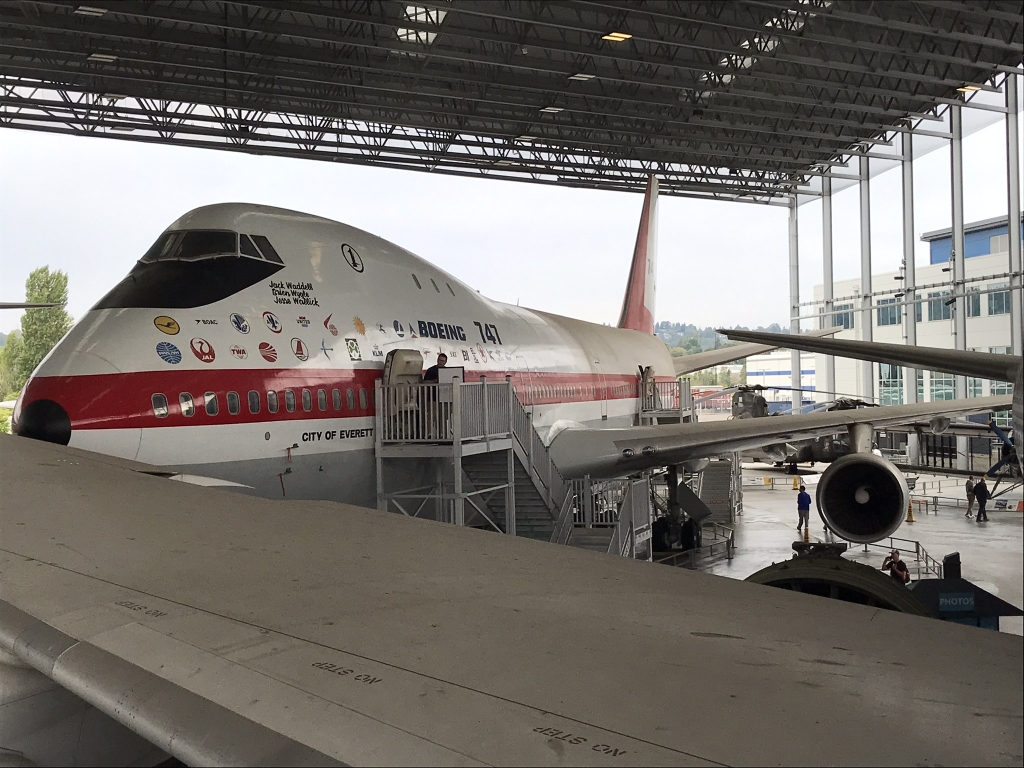
One more plane to walk through: the very first 747 that ever flew, City of Everett.
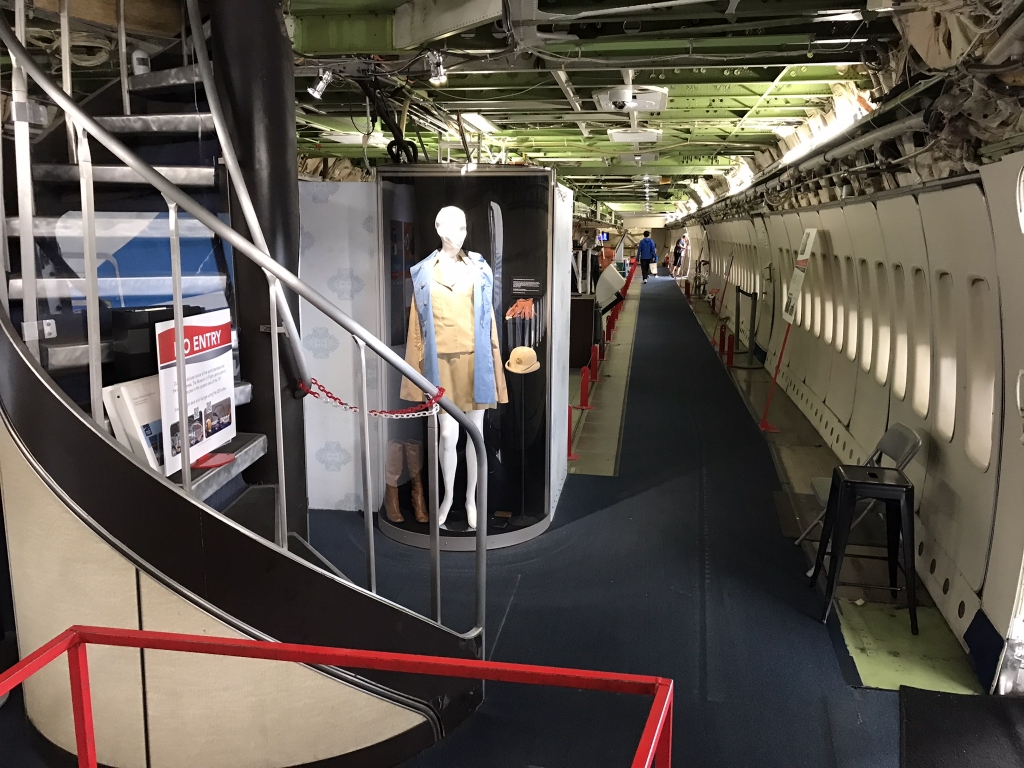
The City of Everett was the prototype for the 747, Boeing's most iconic and recognizable passenger jet. It was this particular 747 that made that type's first flight back in 1969. The interior was never finished since it wasn't put into regular service.
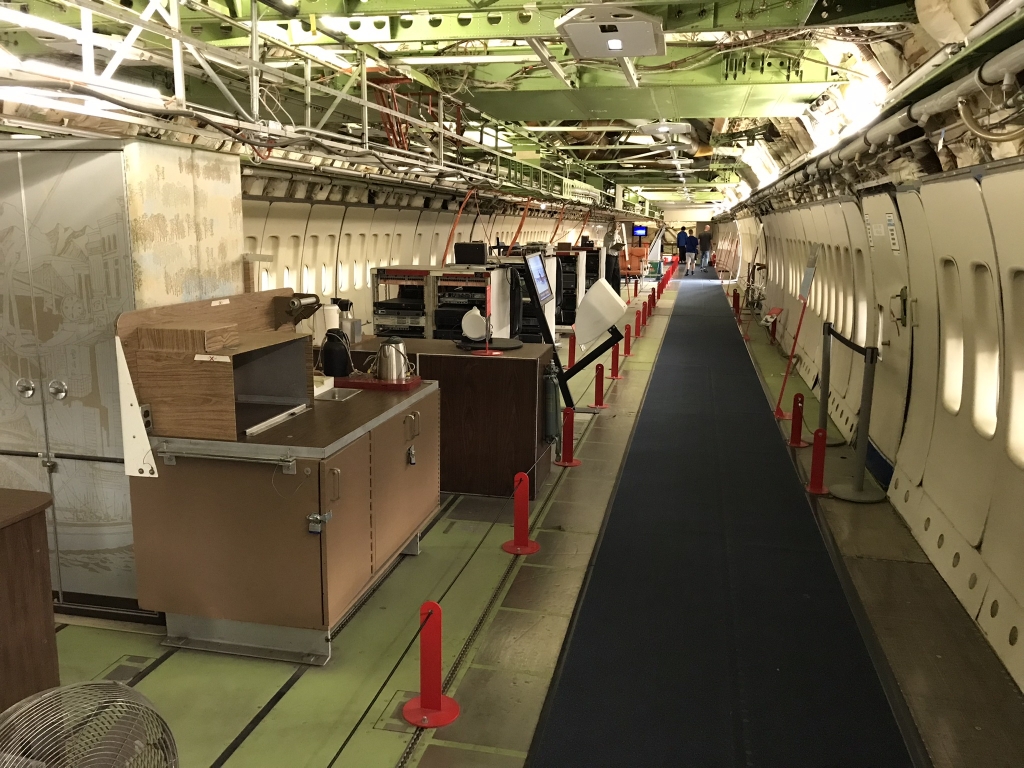
The two halls we just looked at, the Space Gallery and Aviation Pavilion, are on the west side of Marginal Way. A covered foot bridge connects these with the other half of the museum on the east side of the road. After crossing the road on the bridge, before heading into the other halls, I stopped at their restaurant, the Wings Café.
After the tofu noodle bowl I had for lunch, I stepped into the T.A. Wilson Great Gallery where they have a great many planes and a few spacecraft on display...
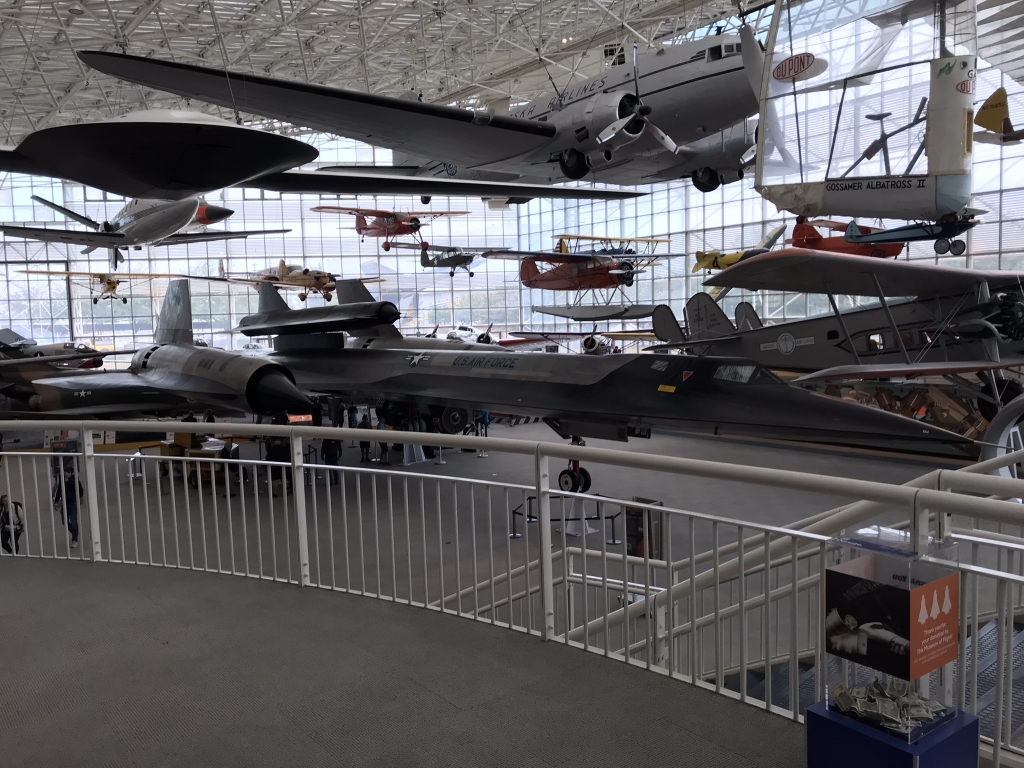
Taking up most of the space here is a legendary spy plane, an SR-71 Blackbird. Sitting on its back, between the two tails, is an experimental D-21B drone which was meant to fly unmanned spy missions, launched in midair from an SR-71, but after a crash during a 1966 test mission the drone project was cancelled.
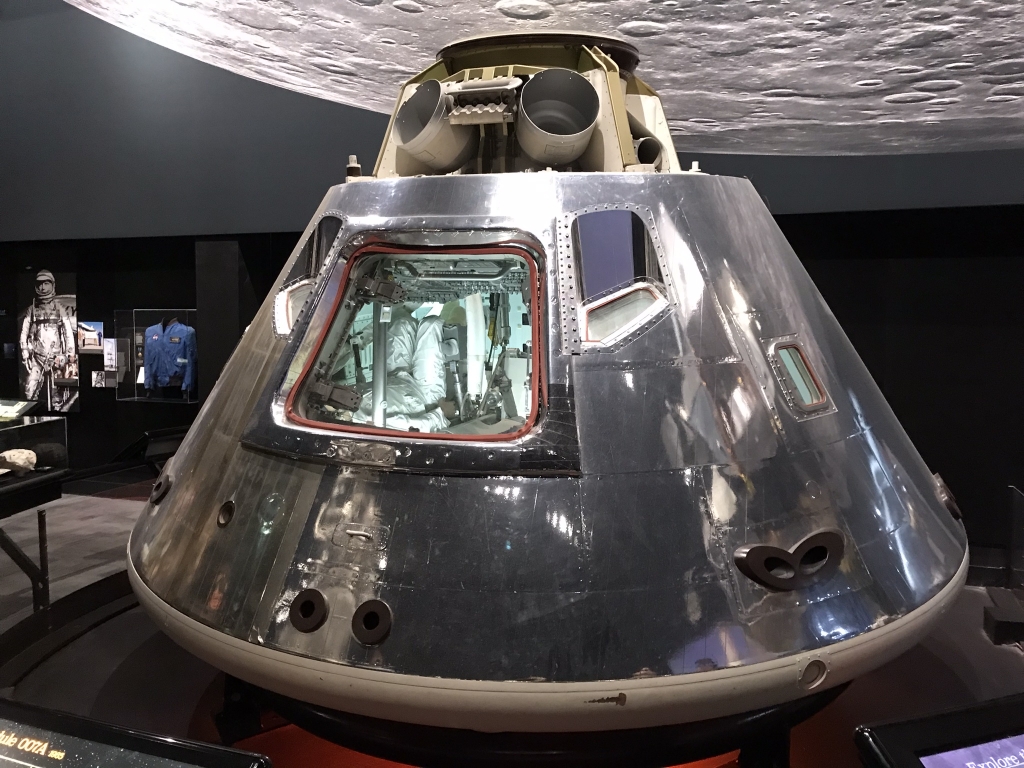
Here's an Apollo command module, just like those that astronauts flew to the moon in the late '60s and early '70s. This one never actually flew in space, though. It was used by Apollo astronauts extensively for training and testing during that era. Now let's peer inside, because there's a lot more room inside than you might expect.
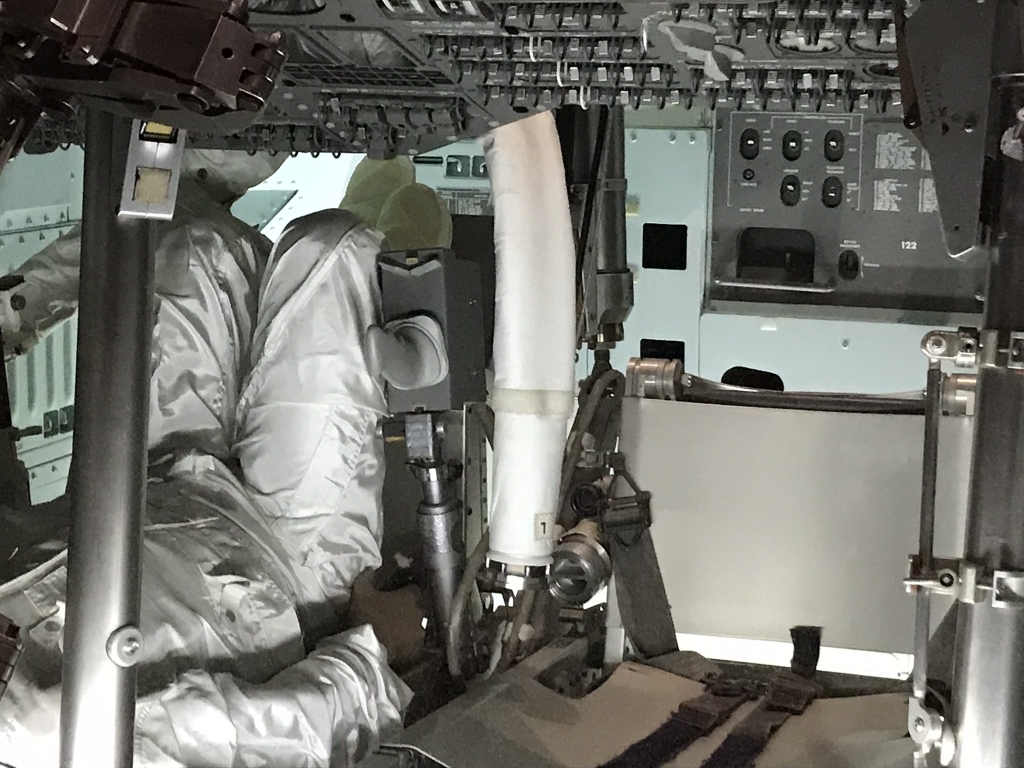
Every Apollo capsule had three seats side-by-side for the three crew members. It wasn't possible to capture them all in one photo. Underneath those seats is where the lot more room inside than you might expect can be found.
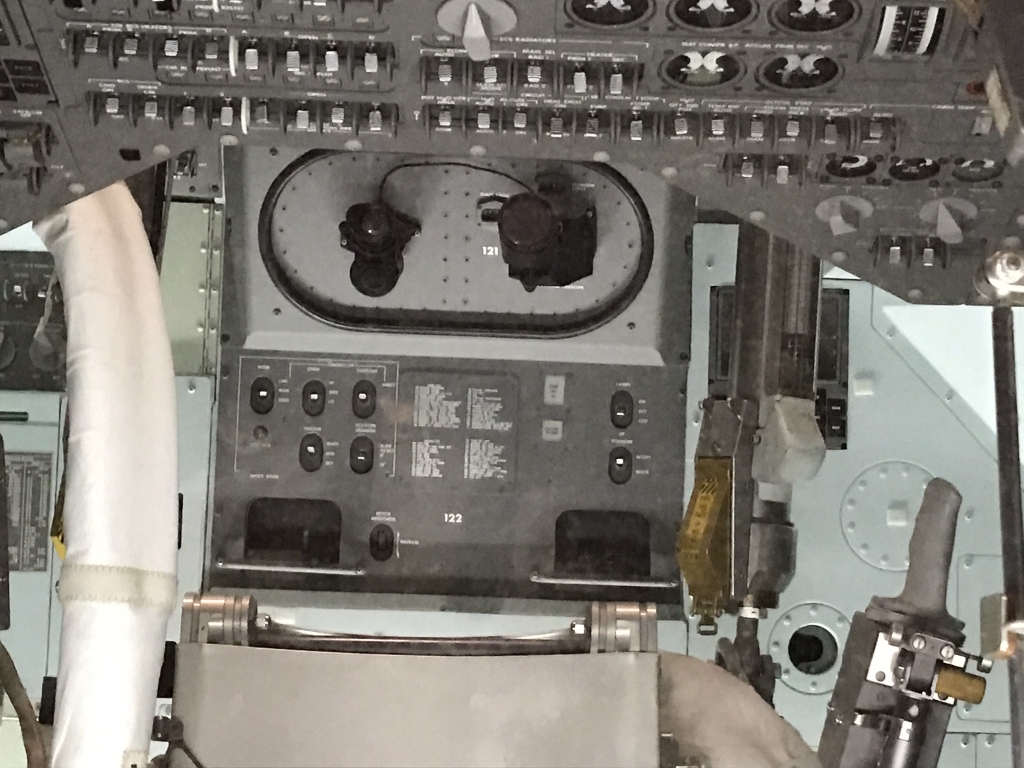
That's a navigation instrument in the center of this photo, under the seats. As you can see, someone using it would be facing straight ahead (from my perspective behind this camera) while anyone in the seats would be facing upward. Meanwhile, to someone in a seat, the person using the navigation station would appear to be facing downward. It may seem a strange configuration at first, but this is moot in zero gravity.
Next to the Great Gallery is the Red Barn, which in a bygone era was Boeing's original manufacturing plant.
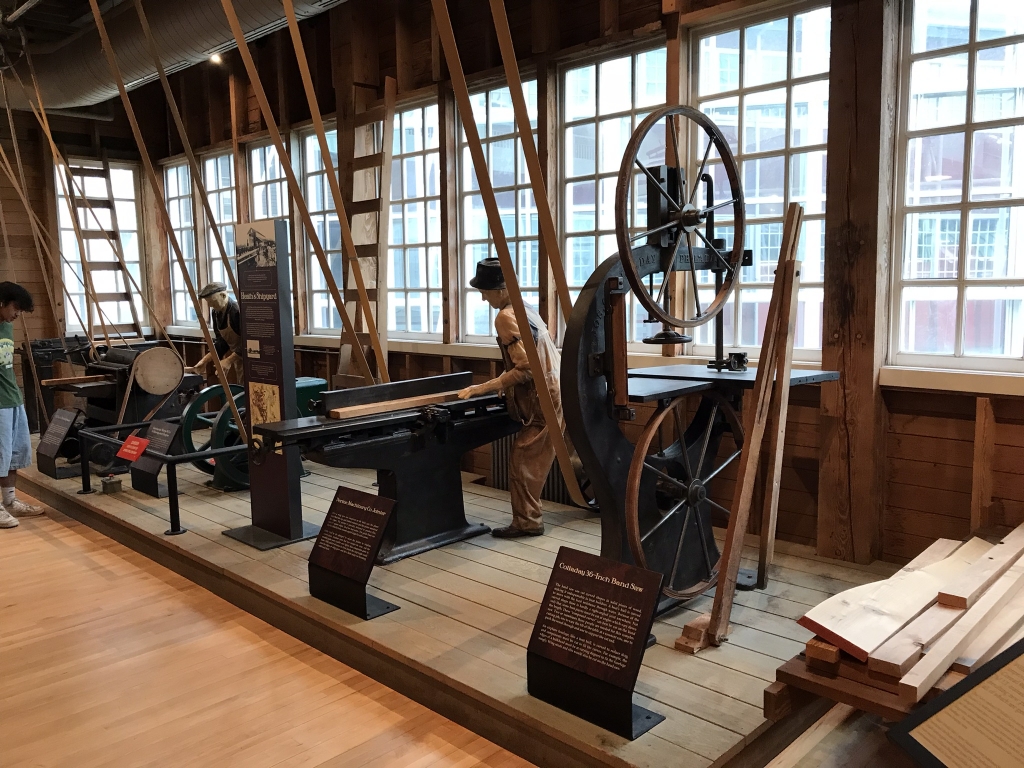
Some of the machinery used in those early days.
A large part of the Red Barn had models of real and conceptual space stations.
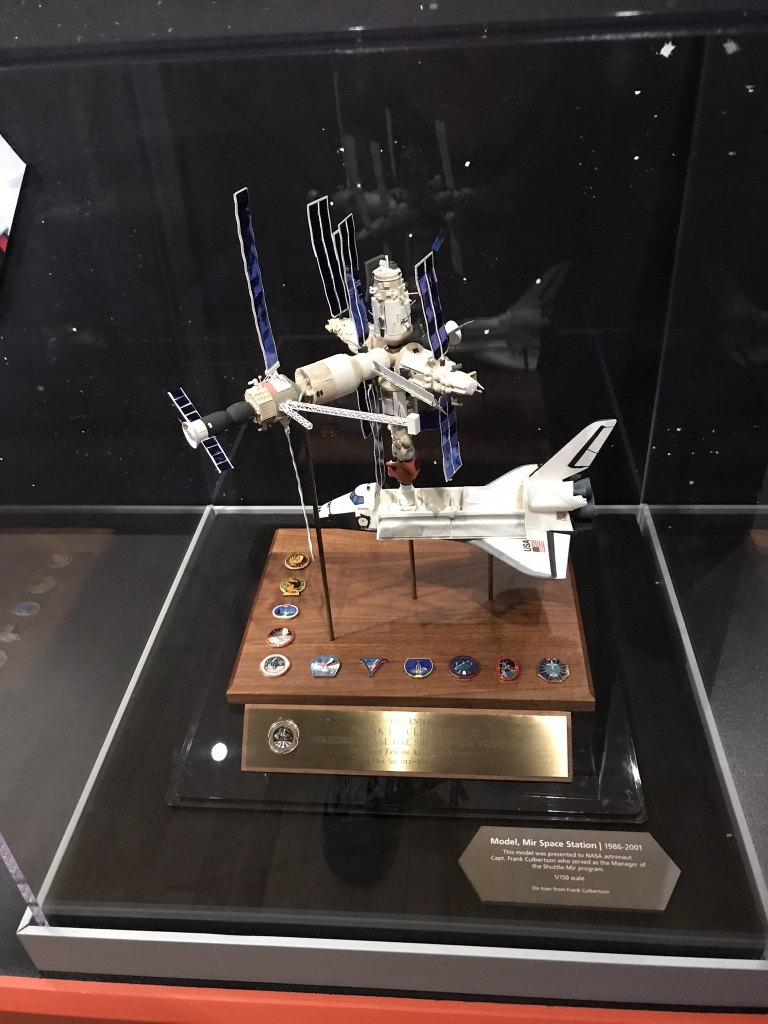
This is the Russian space station Mir, with the US Space Shuttle Atlantis docked with it. This space station was first put in orbit in 1986 by the Soviet space agency, and during the '90s, after the fall of the Soviet Union, it regularly hosted American astronauts who arrived on Space Shuttles. The Shuttle-Mir Program ended in 2001, after which the aging station was deliberately burned up in the atmosphere and replaced by the International Space Station we know today.
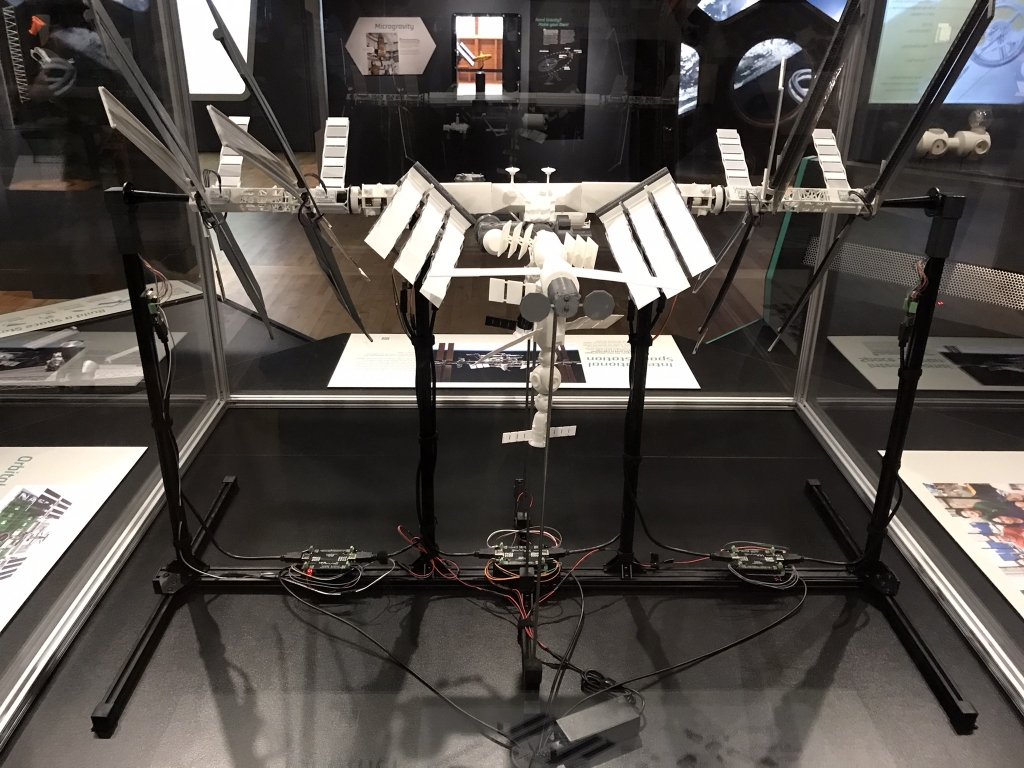
Here's a model of the International Space Station (ISS). But this isn't just any model, it's an "ISS Mimic" which uses an Arduino to rotate all the solar panels so that they're always in the same positions as those on the real station. It was designed by a team of Boeing engineers who worked with Woof3D, the 3D-printing club at the University of Washington.
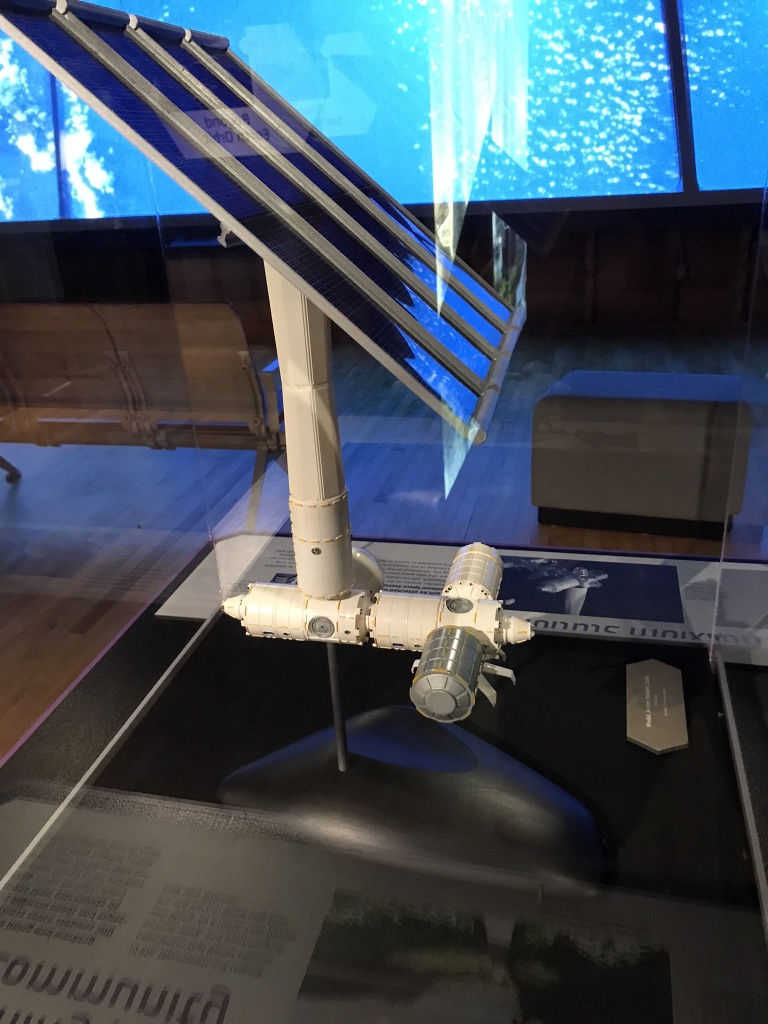
This is called Axiom Station, designed by four companies that received government contracts. It consists of four modules, the first of which is scheduled to launch in 2025. Axiom's modules will be first attached to the ISS, and then will eventually replace it as the ISS is retired and disposed of.
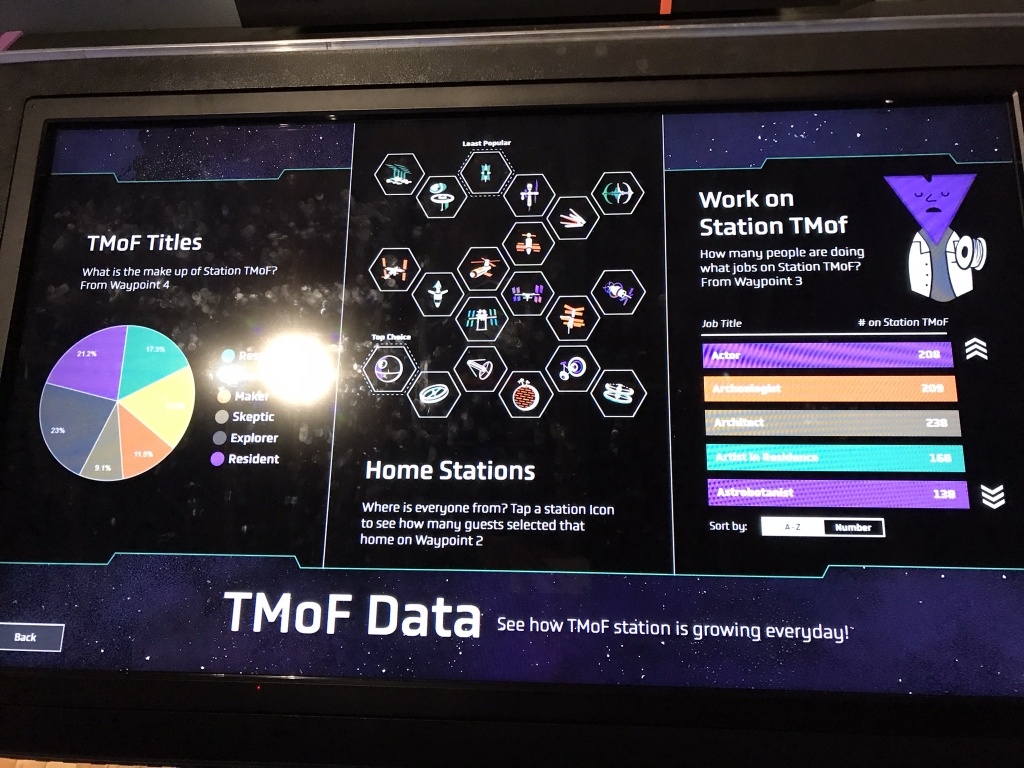
They had a fun interactive game here where you can find out what role you would fill on a fictional space station.
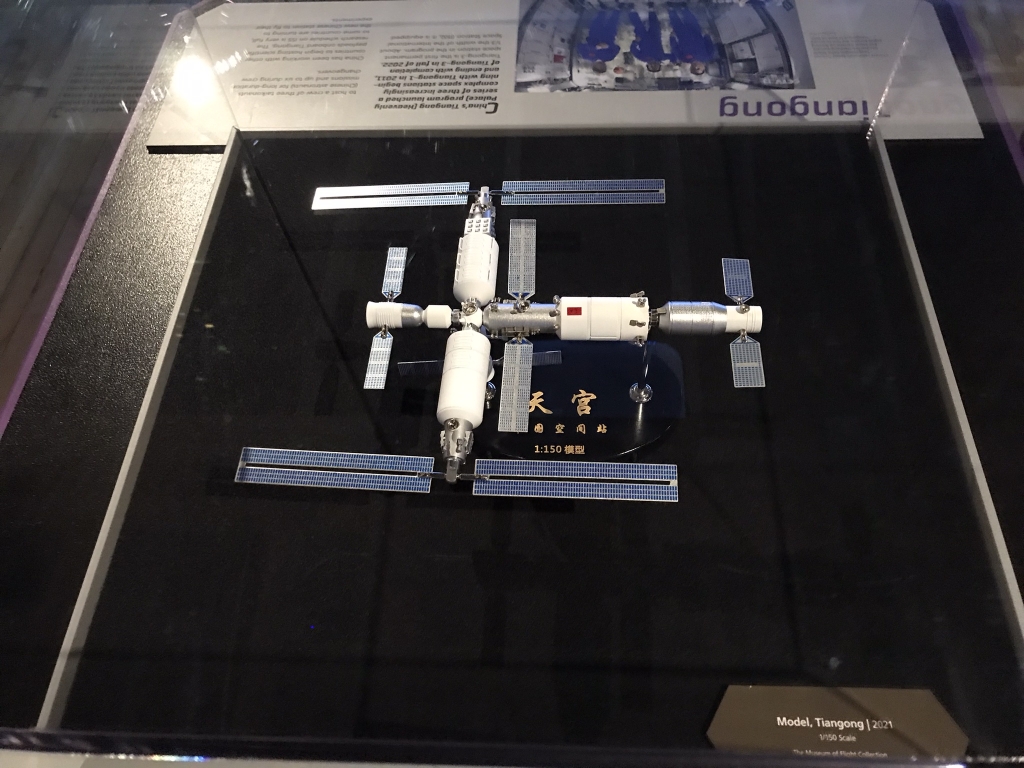
I mentioned this a little bit earlier. This is China's space station, Tiangong. It's pretty new; the first module was only launched in 2021. Before this, there were two other test Tiangongs which have since been deorbited.
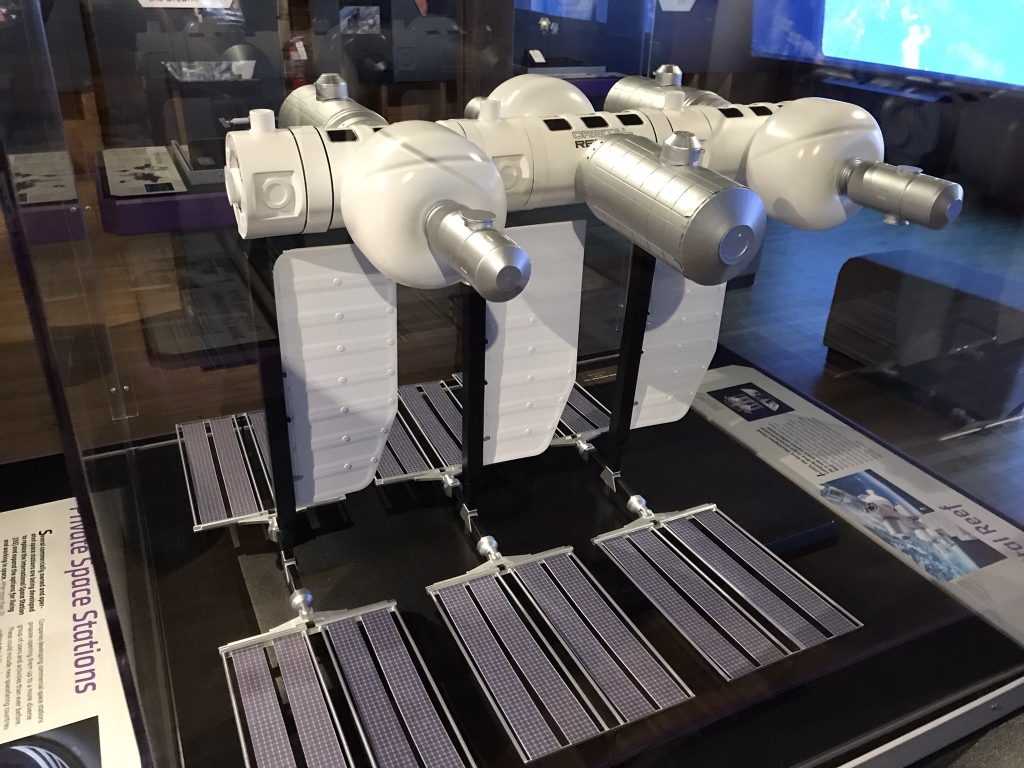
Orbital Reef is being designed by the company Blue Origin which is receiving government funding. Like Axiom, it's meant to replace the ISS.
That was the end of my visit to the Museum of Flight, since I had an appointment elsewhere. Another long ride on bus 124 took me back to the vicinity of the SODO light rail station, from which I rode the train to the U-District.
My other big destination of the day was a tour for potential transfer students at the University of Washington. At that time, I was still in the process of choosing a university to go to, and this was the first one I toured. In the five months since then, I've since opted for Colorado State University because that school had just a few more little things that the others I toured didn't. But attending UW and living up here would still have been real nice.
I didn't take a whole lot of photos during the tour, but I did get a couple of a really impressively designed building.
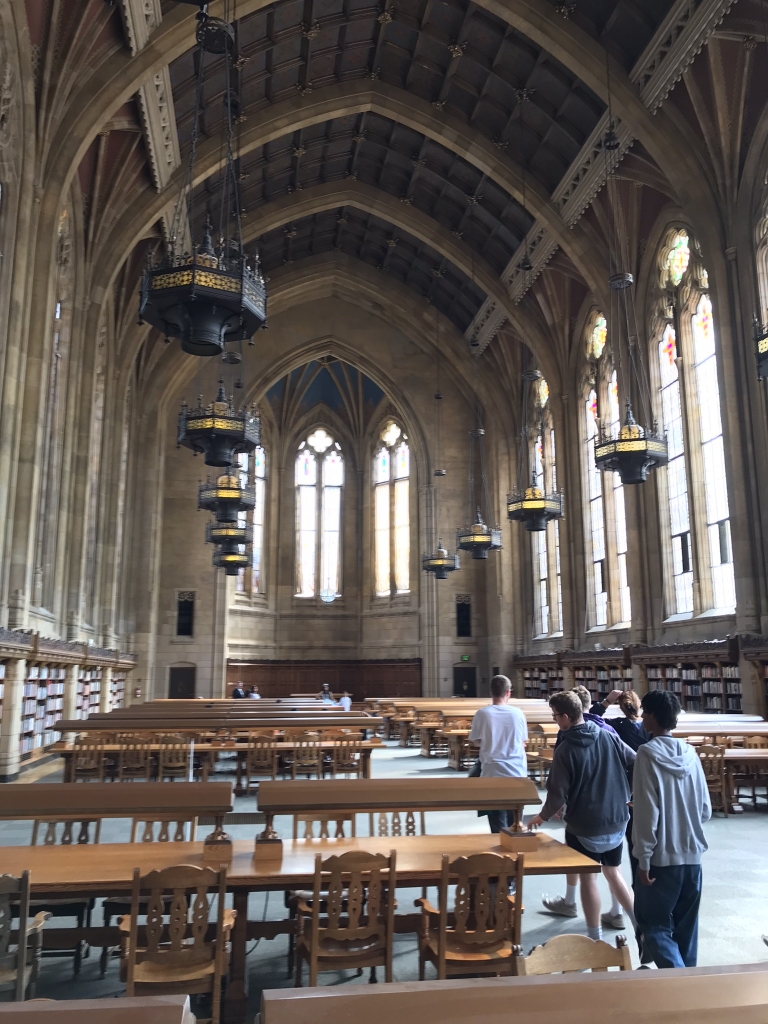
This is Suzzallo Library. Looks like a late-medieval European cathedral, doesn't it? It never was any of those things. The library was built specifcally to be a library, in two phases in 1926 and 1935.
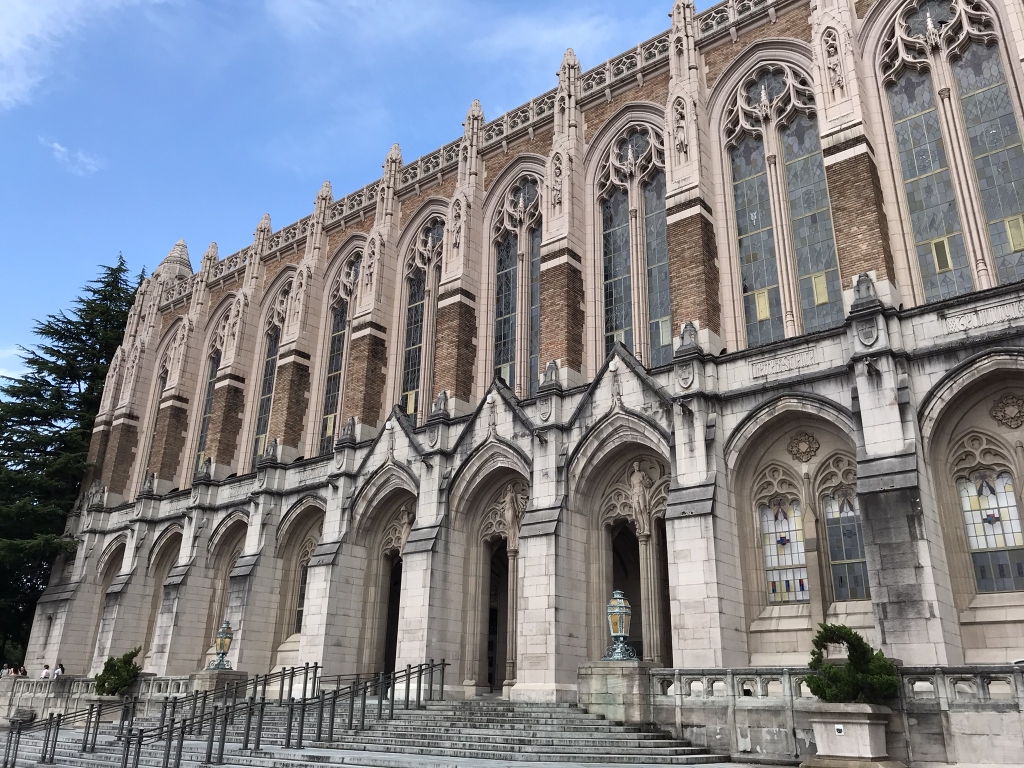
Outside of the library.
Even though I'm sure I'll enjoy living in northern Colorado, looking at these pictures again is starting to make me wonder what could be, if I'd made a different decision.
Before leaving the U-District, I got some great coffee and a muffin at Café Allegro.
With the two most important visits of the day over with, I wanted to find a local pool and swim some laps. This was unfortunately frustratingly difficult and I won't waste much time here detailing my bouncing around from one to another looking for one that was open for lap swim. The one I eventually did find was the Madison Pool.
After being done with my laps at the Madison Pool, I rode a bus from there to Northgate, and from there took a train south back to the U-District, where I knew I could find somewhere to find dinner.
I got dinner from a Thai restaurant, I think it was Thai 65. The dinner was a really heavy noodle bowl.
Wednesday, August 21, 2024
No trouble finding breakfast today, with the leftovers from yesterday's Sunrise Restaurant breakfast still in the fridge.
Unlike the flights up here nearly a week earlier, which had a layover in Salt Lake City, I would be going back to Albuquerque with a layover at LAX. The always-reliable bus E brought me downtown from where I rode a train to the airport. The flight to LAX left on time with me aboard, and it was at LAX where I got lunch from a seafood restaurant, Slapfish.
And now there's one more thing to share from this trip. When the final LAX-ABQ flight took off, everyone on the plane got to see some great scenery outside. After takeoff the plane first flew a few miles west off the coast...
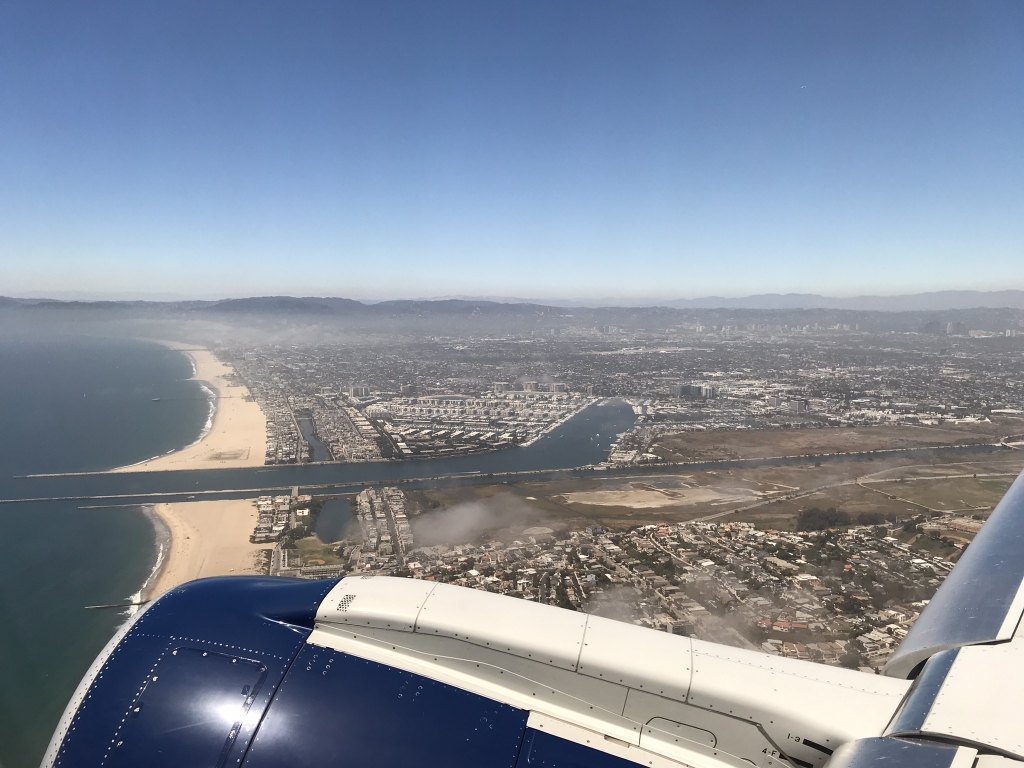
I don't know the area too well so I had to consult Google Maps. We're looking northward at Marina Del Rey here, and beyond that, Venice Beach.
Then over the ocean, the plane finally turned around and flew back over land.
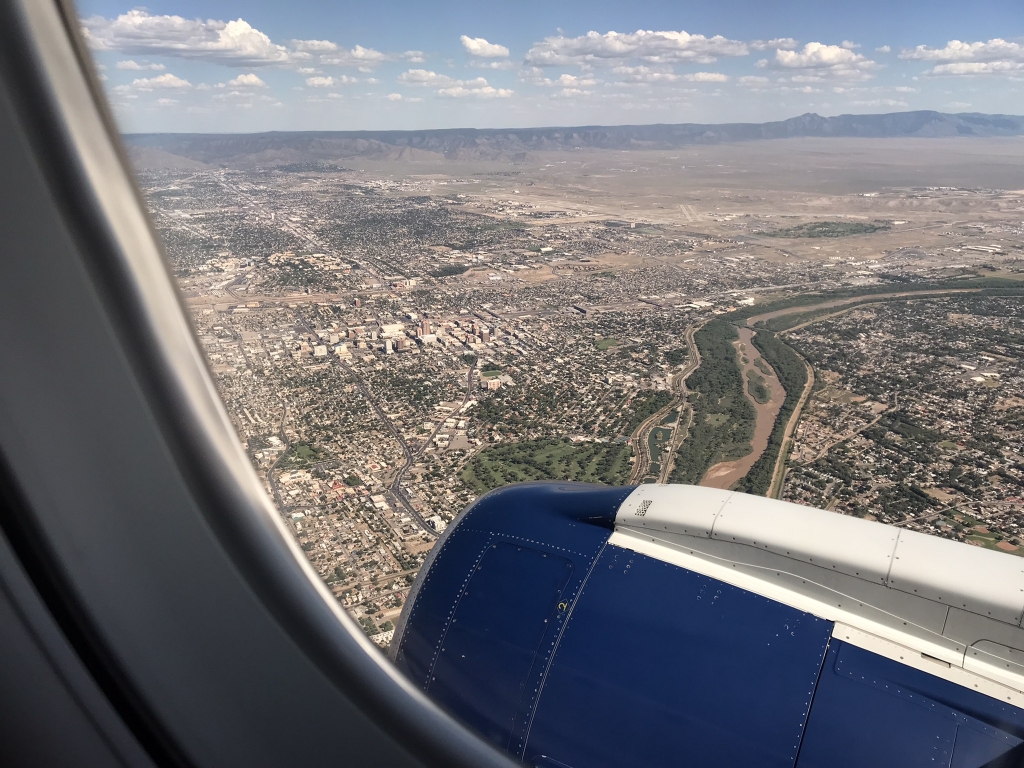
After the turnaround. This is...somewhere in the LA area.

